Greek and Roman Art test 3
1/99
Earn XP
Description and Tags
Name | Mastery | Learn | Test | Matching | Spaced |
|---|
No study sessions yet.
100 Terms
Etruscans borrowed from the Greeks
Wall paintings told stories and used motifs/symbols/decoration
Columns at the Temple of Veii inspired by Greek doric columns, but adapted to “tuscan” style wooden columns
Adopted a similar alphabet to Greeks, also some of their mythology
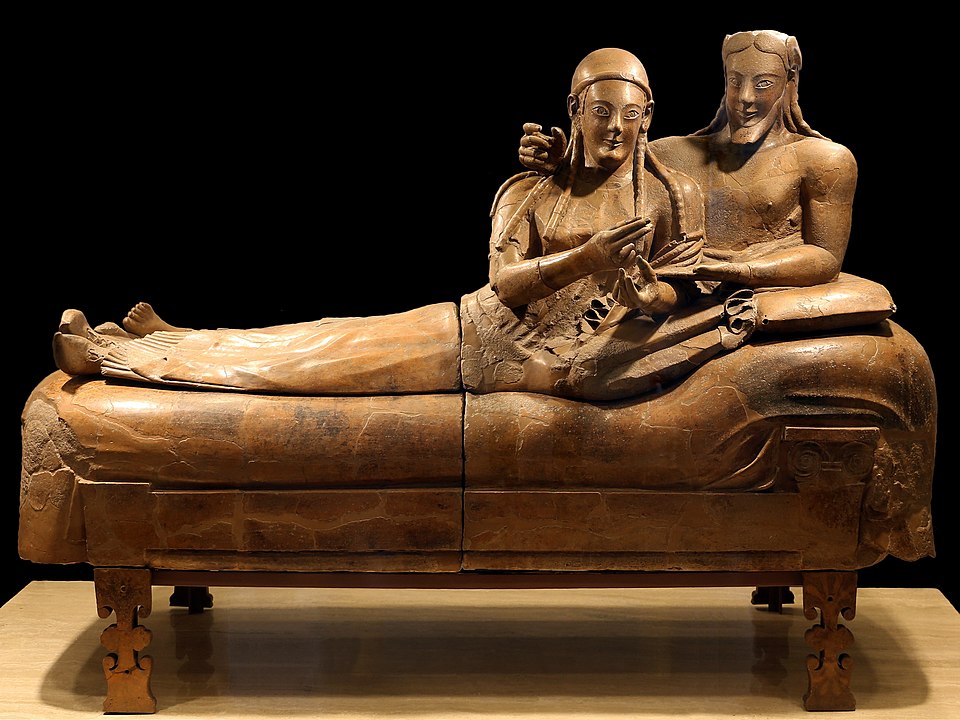
Terracotta Sarcophagi from Cerveteri
Made out of terra cotta, lack of hard stone in tuscany
6ft 7
C. 510 BCE (Etruscan period)
Found in a cemetery, made to hold the ashes of a couple
Made in pieces, cannot bake clay that large
Unsure if these were representations for the afterlife as there were only details from the waist up
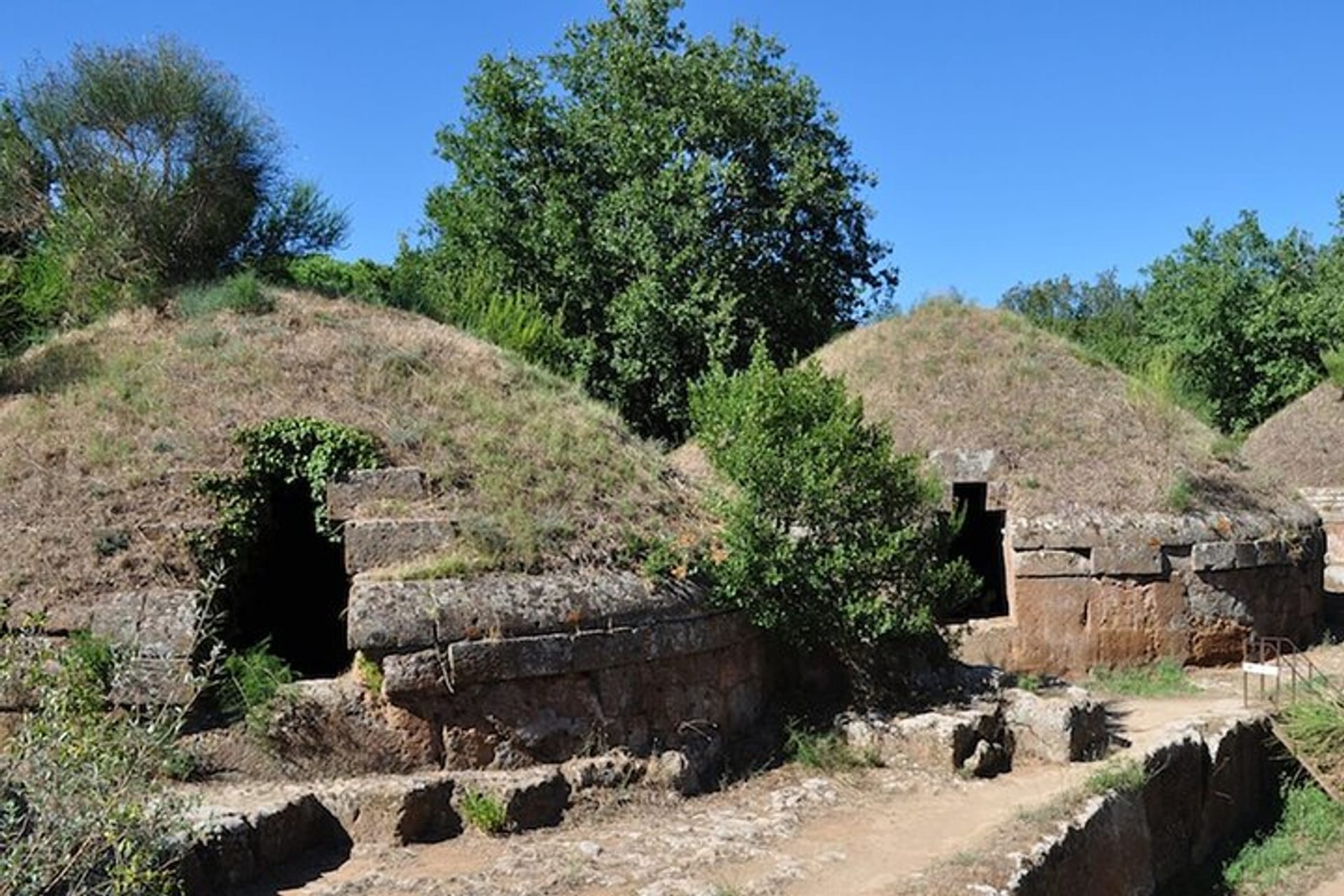
Cemetery at Banditaccia, Mounds
Etruscan period
Mound tombulus
used for Etruscan burials and various burial practices.
Often housed multiple chambers and contained offerings for the deceased.
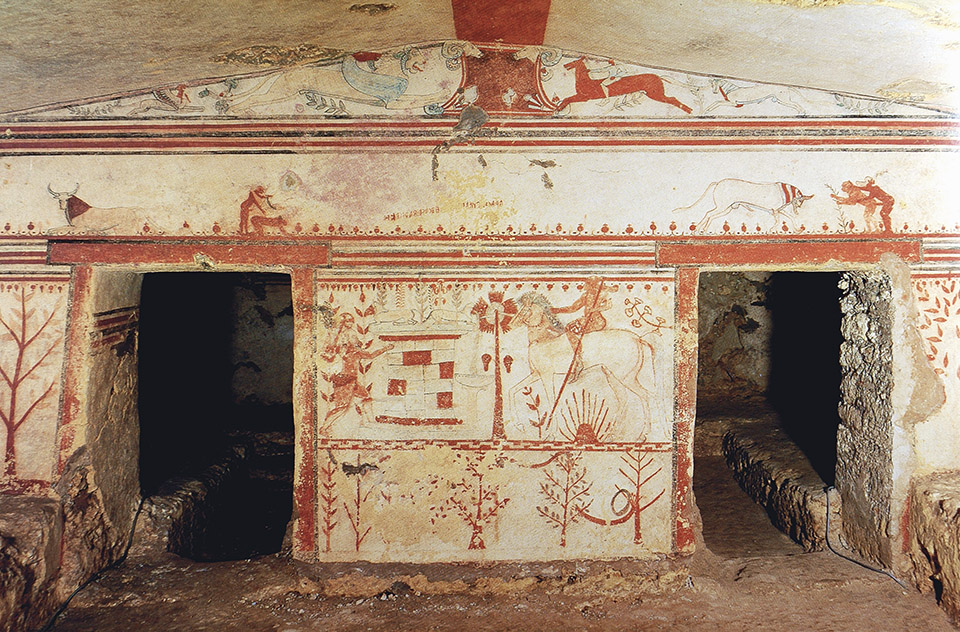
Tomb of the Bulls
C. 540 BCE (Etruscan period)
Main room with two side chambers
Sex scenes surrounding the main imagery including intercourse between two men about to be trampled by a bull as well as a threesome near a bull laying down
The bull charging has an erect penis, the one laying down does not
One section shows Achilles and troilus story
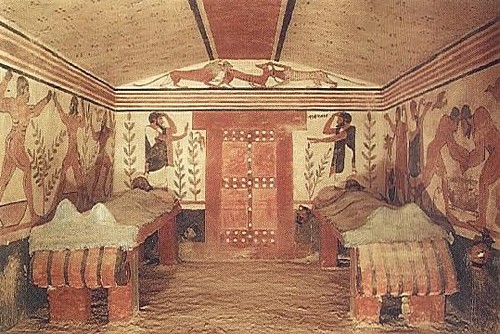
Tomb of the Augurs
C. 530 BCE (Etruscan period)
In city-state Tarquinia
One wall shows a painted door and two men in a mourning gesture
Top shows a leopard and lion killing a deer
Right wall shows a scene with special priests called augers that watched birds to decipher what the gods were trying to tell them or a gladiator fight at a funeral
Semi god Phersu on the right is overseeing the torture of a man with a dog
Left wall shows phersu by himself
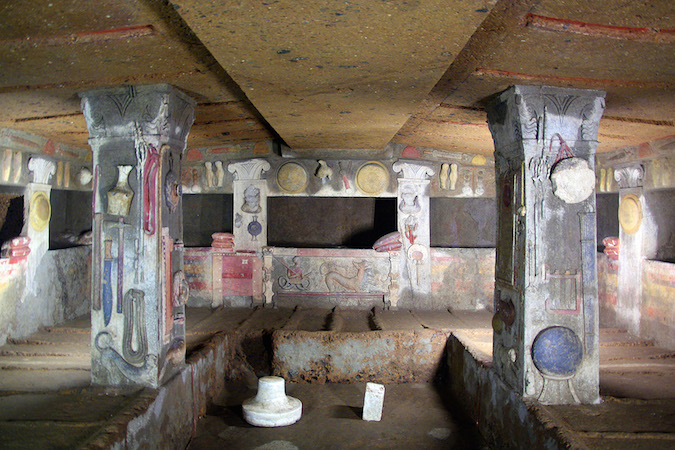
Tomb of the Painted Reliefs
300 BCE (Etruscan Period)
Excavated into the stone
Stone pillars with incised designs, painted weapons and platters
Well in the center with niches behind it, niches would hold urns
The main niche shows a demon human with serpent legs behind a 3 headed dog (Cerberus)

Temple of Menerva at Veii c. 500 BCE
500 BCE (Etruscan period )
Entire roof decorated with statues and reliefs, emphasizing Etruscan architectural style.
The temple is dedicated to the goddess Minerva
features a deep porch and vibrant terracotta sculptures.
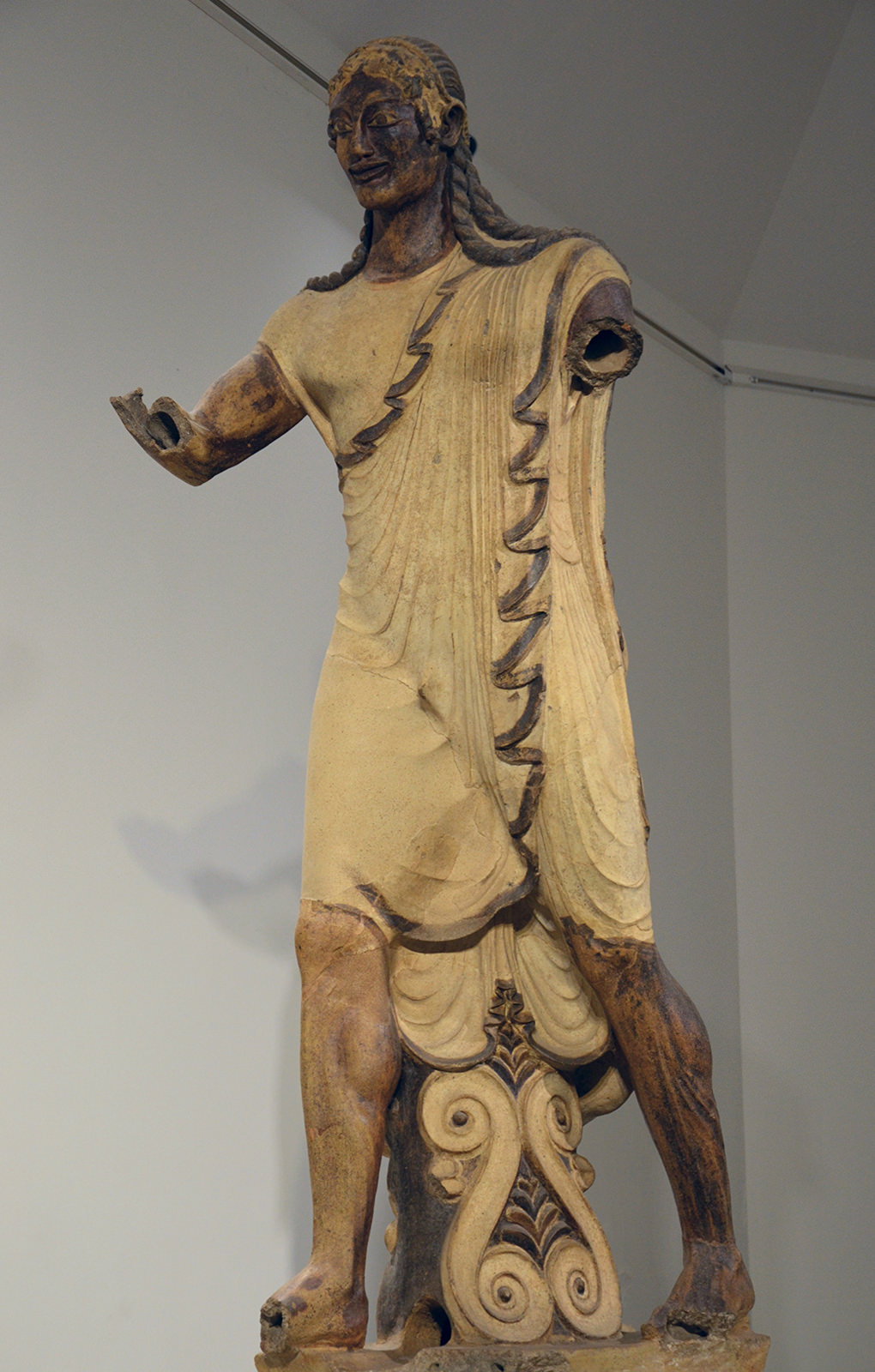
Apollo of Veii
Terracotta
5’10
Vaguely similar to greek kouros
Painted features
Draped clothing
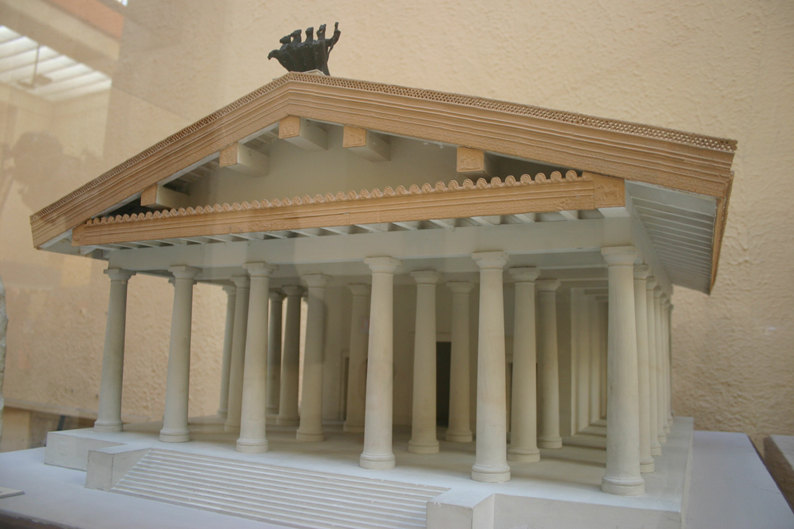
Model of Temple of Jupiter Optimus Maximus Rome c. sixth century BCE
honored the Capitoline Triad of Roman deities: Jupiter, Juno Regina (Juno the Queen), and Minerva
significant location on the Capitoline Hill of Rome
Juno (goddess of women), consort of Jupiter, Minerva (goddess of handicrafts), Jupiter's daughter
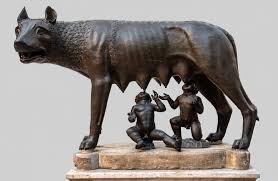
Capitoline Wolf
A bronze sculpture depicting a she-wolf nursing the twins Romulus and Remus, central to Roman mythology
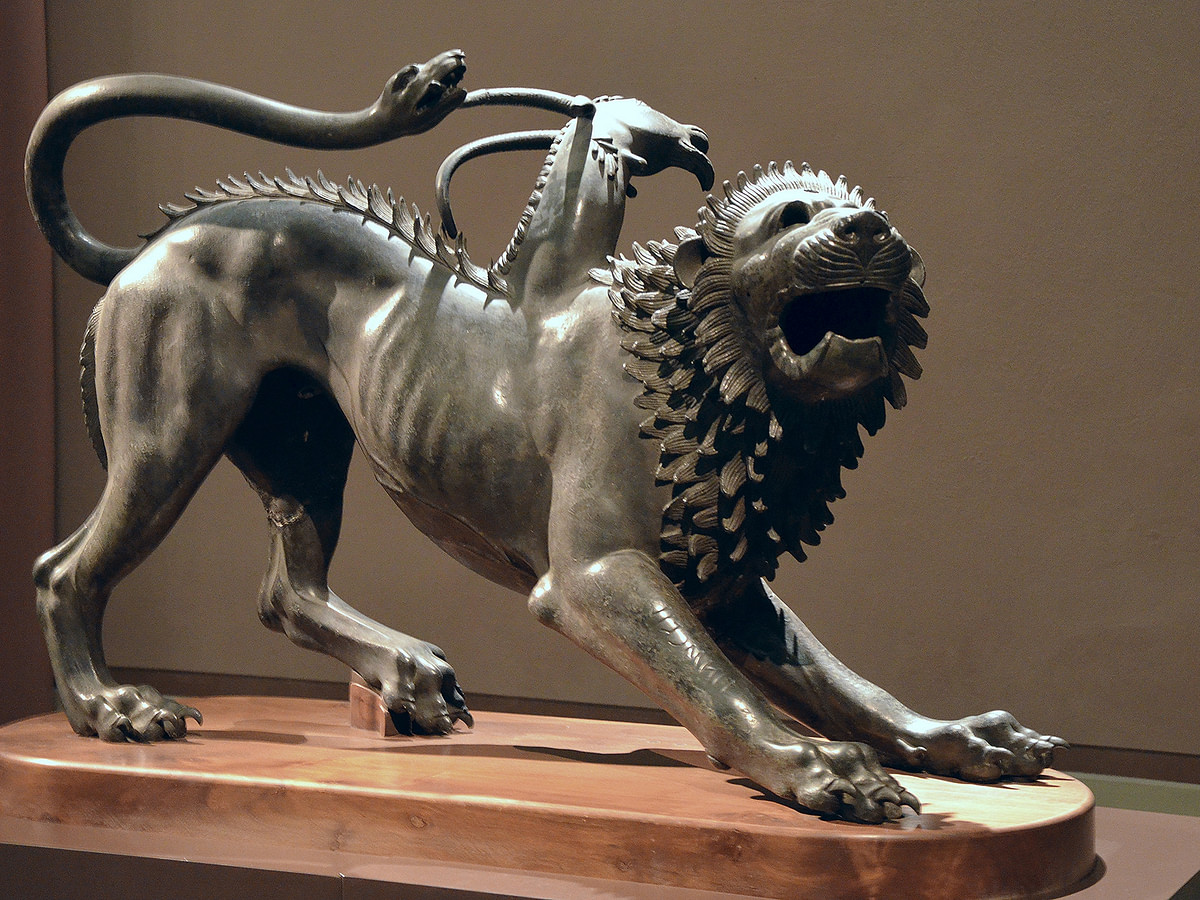
Chimaera c. 390 BCE
depicted as a lion with a goat's head protruding from its back and a tail ending with a snake's head
It was an offspring of Typhon and Echidna and a sibling of monsters like Cerberus and the Lernaean Hydra

Head of a Boy c. 310 BCE

Terracotta portrait head first century BCE

The Orator
5’11
Bronze
Early 100s BCE (Etruscan Period)
Wearing a toga with his name inscribed
His name is Latin but his family name is Etruscan
Face is almost expressionless, realistic, non-beautiful
Double chin, wrinkles, wiry hair
Arm is restored
his posture seems to be that of the orator who is in the process of addressing the crowd
He wears a tunic over which is draped a toga—the formal attire of the magistrate
On his feet are the high boots that were commonly worn by Roman senators
story of Troilus and Achilles
In Greek mythology, the story of Troilus and Achilles involves Troilus, a young prince of Troy, whose death at the hands of Achilles is foretold by prophecies, marking a significant moment in the Trojan War.
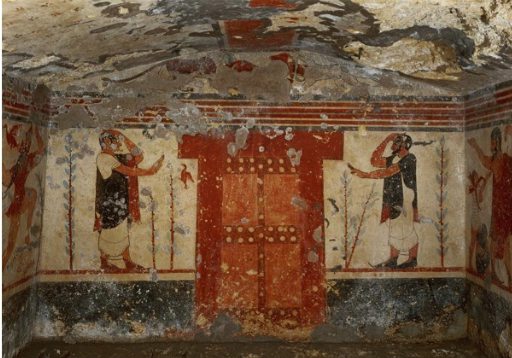
Augurs
Priests in ancient Rome who interpreted omens and signs (through bird-watching) to guide public policy and military decisions.
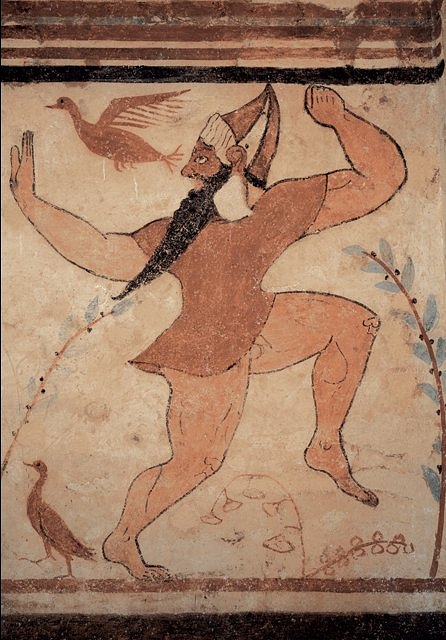
Phersu
A masked figure in Etruscan funerary games, depicted in art as engaging in ritualistic combat, often associated with death rites
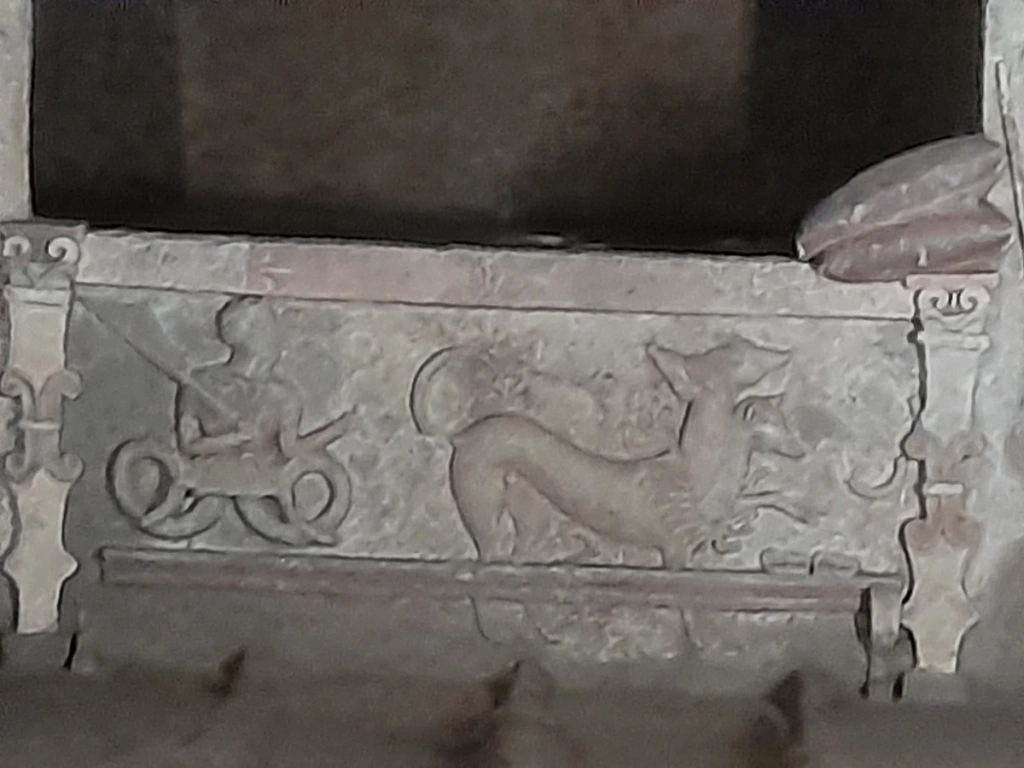
Cerberus
A multi-headed dog from Greek mythology that guards the entrance to the Underworld, ensuring that the dead do not escape
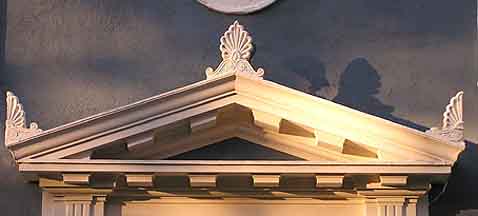
Acroteria
Architectural ornaments placed at the apex and corners of a roof, typically found on temples in ancient Greek architecture
Sculptor Vulca
The most renowned Etruscan sculptor, known for creating significant works such as the Apollo of Veii
Juno
The queen of the gods in Roman mythology, protector of marriage and childbirth, often associated with the Greek goddess Hera
Minerva
The Roman goddess of wisdom, warfare, and crafts, often identified with the Greek goddess Athena
Romulus & Remus
Twin brothers and “founders” of Rome, raised by Capitoline Wolf, symbolizing the origins of the city of Rome, legend where Romulus kills Remus.
Aulus Metellus
Senator depicted in the Orator statue

Temple of Portunus
Sides and back have columns half in a wall
Ionic frieze made of stucco (has since fallen off)
Frieze is decorated with garlands, putti (cupids), and bucrania (sacraficial animal skull)
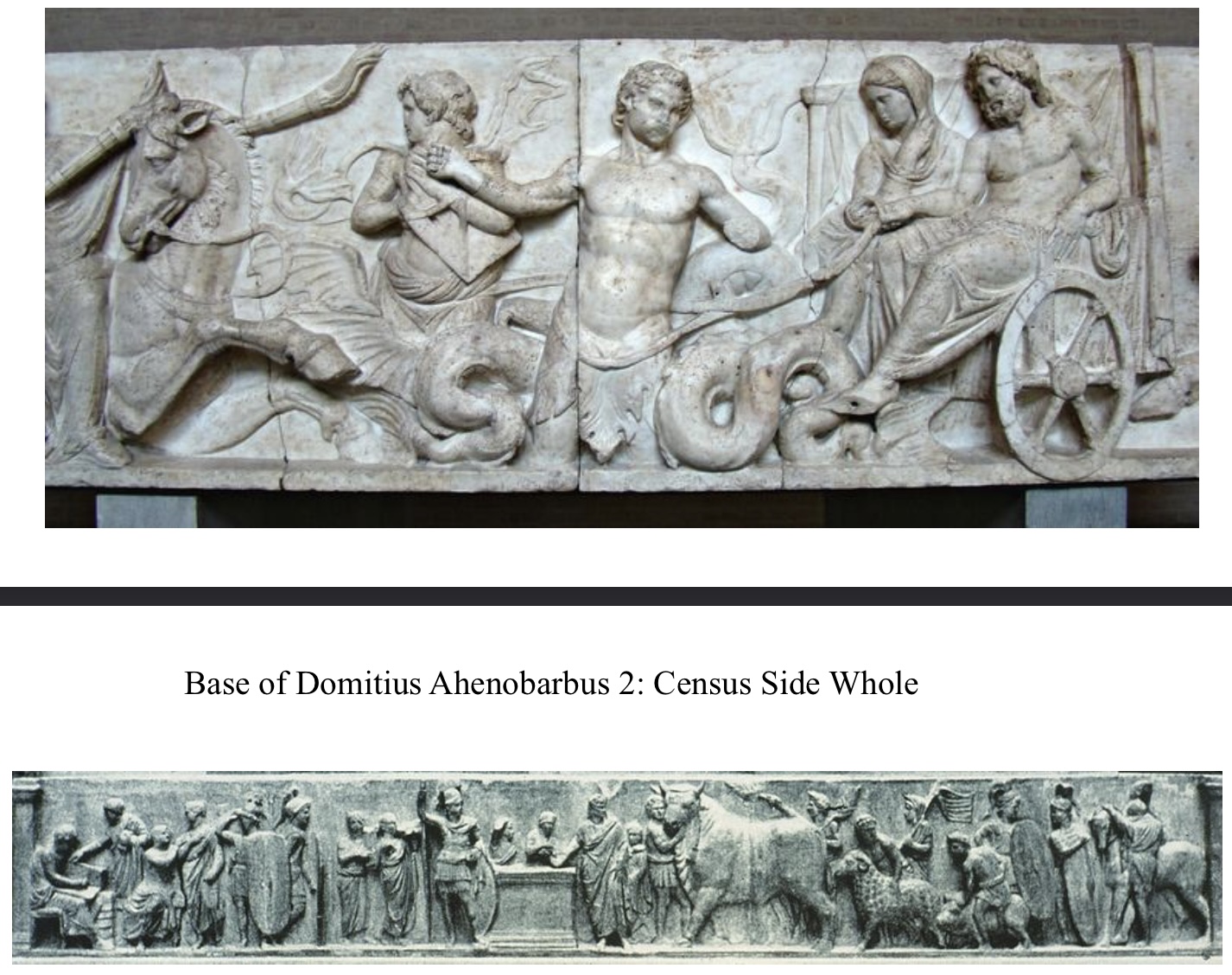
Domitius Ahenobarbus base
2’8
Late 100-200 BC
Made of 3 slabs of marble that were imported from Greece and possibly used as a statue base, 4th side was not imported and likely carved in Rome
Greek sides were creative and supernatural, the roman side shows stiff human figures at a census (early roman senate meeting to determine voting groups)
Shows the marriage of neptune and his wife
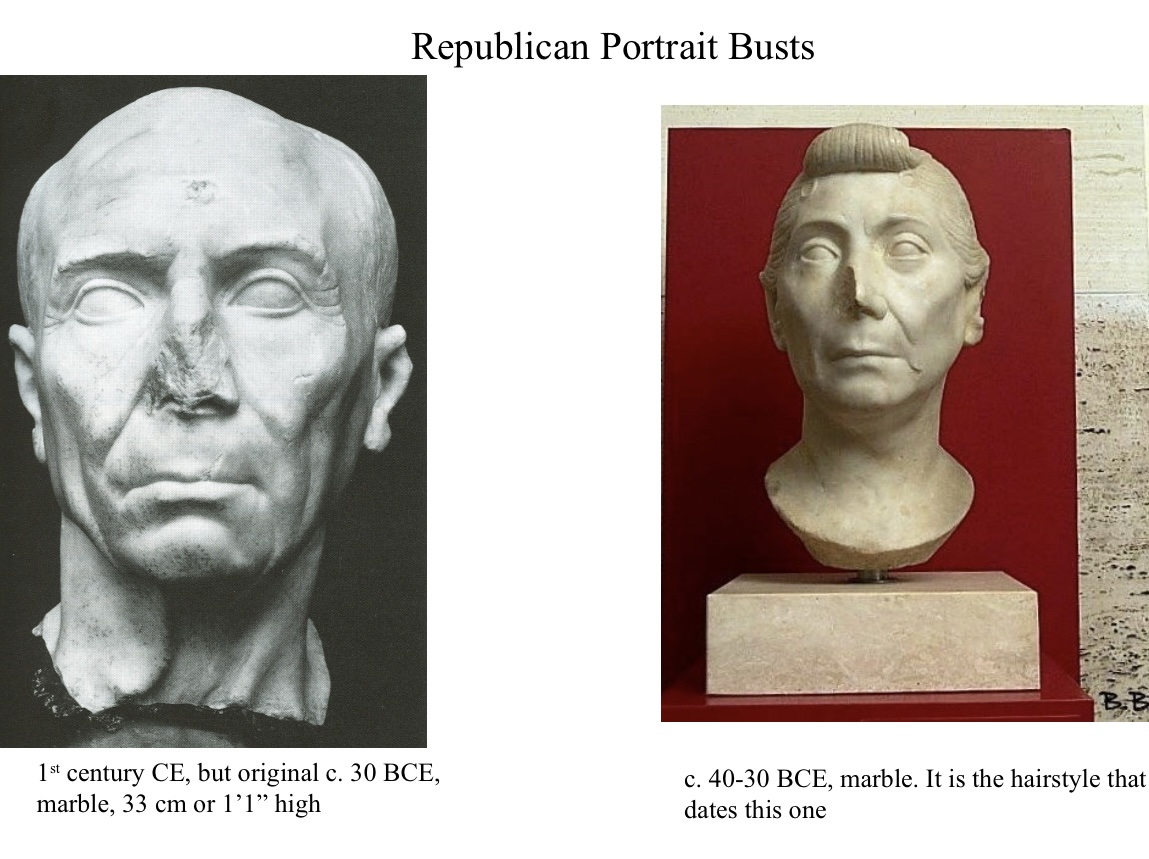
Roman portrait busts
Commissioned busts, did not want to look Greek because “romans live a harder life” so they wanted to look more rugged/realistic than greek statues
Left picture - 1st century bc, marble, 1’1, was not originally carved in marble, man
Right picture- 30-40 bc, marble, very specific hairstyle dates it to the time period, woman
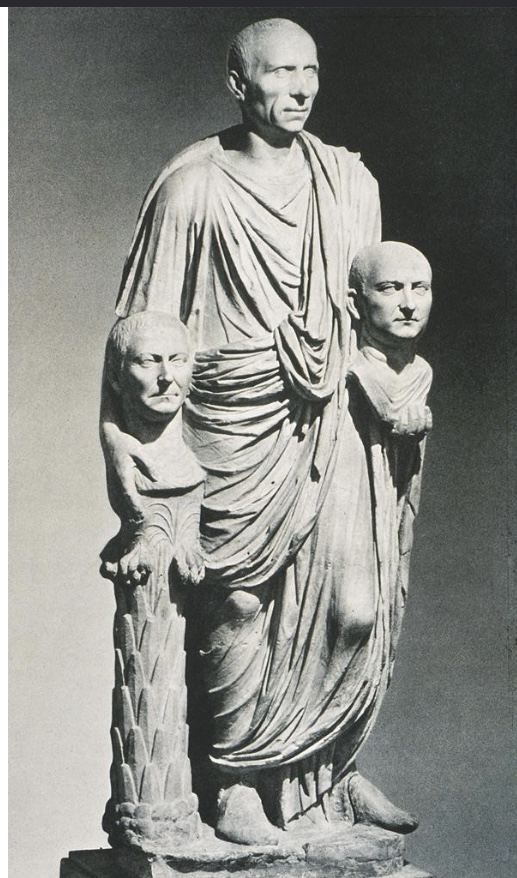
Patrician statue carrying portrait heads
5’5
may be a copy of an original
family comes from Etruria - possibly middle class bc of smooth features and short hair
wearing a toga
togatus baberini
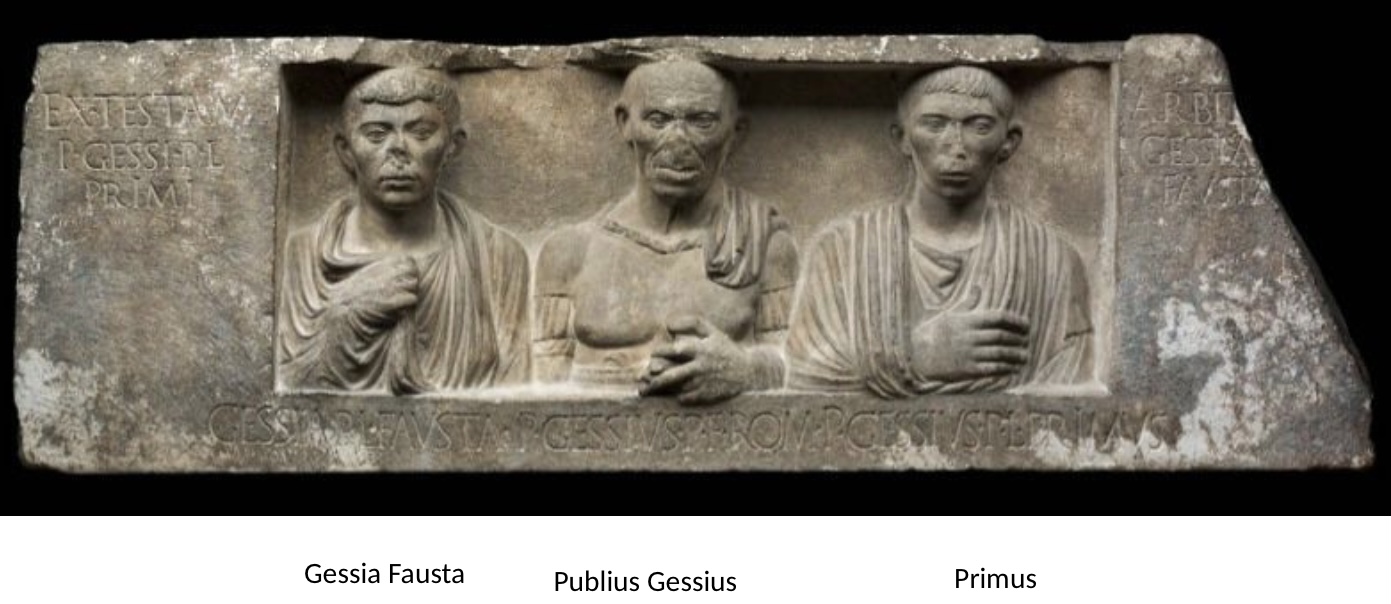
Gessius family tomb relief
from a tomb
2’ high 6’ long
figures are gessia fausta, publius gessius, and primus
publius gessius is a soldier, gessia is a woman, primus is a young man in a toga
possibly a family group but names don’t align
inscription states gessia is a “freed woman”, publius is from a Roman tribe, and primus is a “freed man”
all 3 were “slaves of a man named publius”
gessia was possibly the the wife of publius gessius and primus their son (or a son)
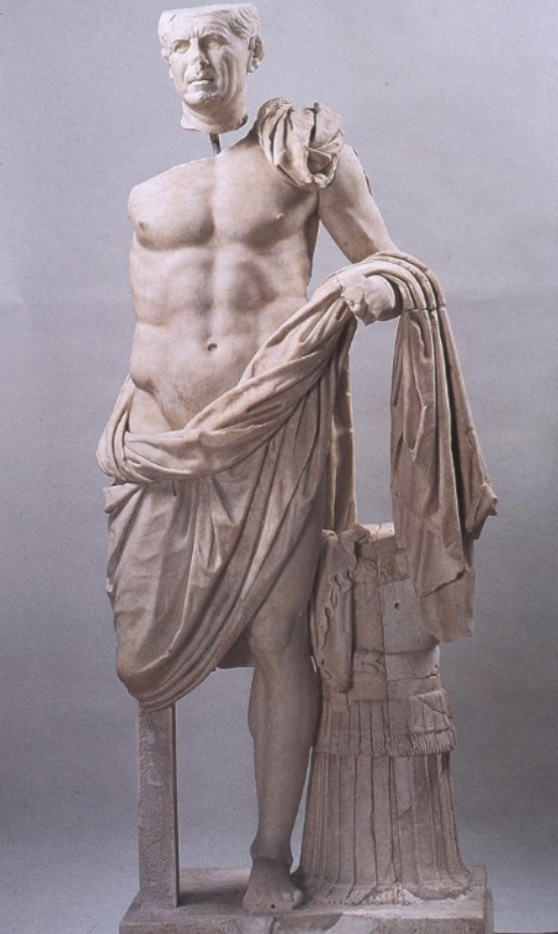
Tivoli general
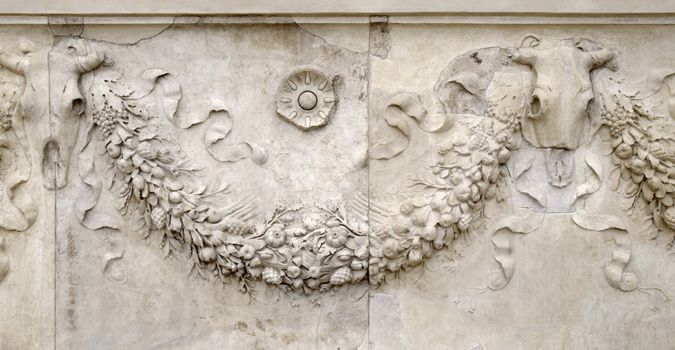
Garland, putti, burcrania
Types of ornaments: (in order)
Flowers/fruits/plants, often depicted in wreaths
Small Cupid-like figures
Sculpted bovine skulls, usually ox
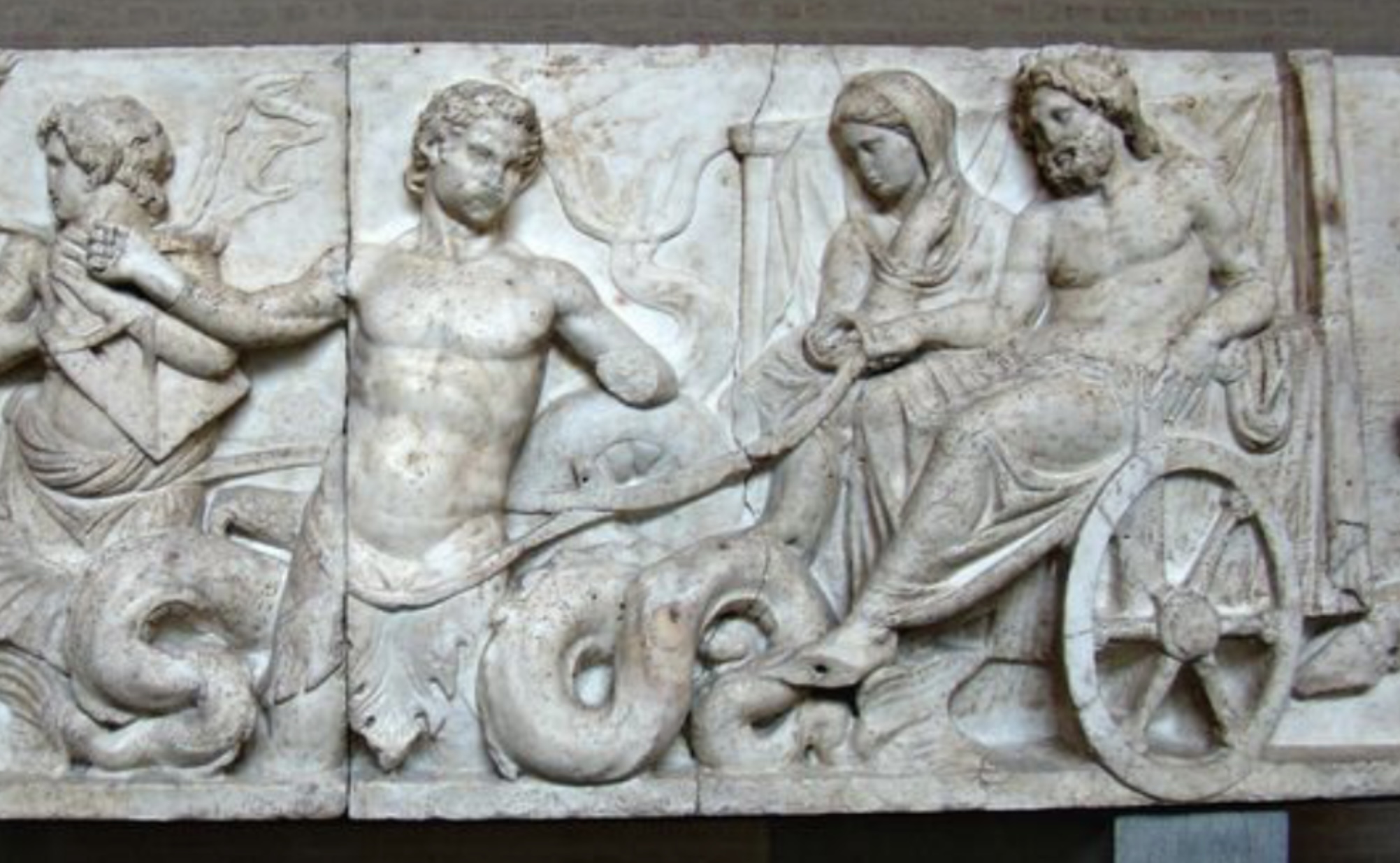
Neptune and Amphritrite
Amphitrite was the daughter of Nereus, a child of the primordial deities Pontus (Sea) and Gaea (Earth). Neptune had fallen in love with Amphitrite, but she fled from him and sought refuge with Atlas. Among those the god of the sea sent out to look for her was Delphinus (the Dolphin), who managed to find her. In gratitude, Neptune turned Delphinus into the constellation Dolphin.

Census
A national register prepared at Rome, on the basis of which were determined voting rights and liability for military service and taxation.

Mars Suovetaurilia
A sacrifice of a sheep, a pig and a cow performed by the Roman army as a sacrifice to the war-god Mars
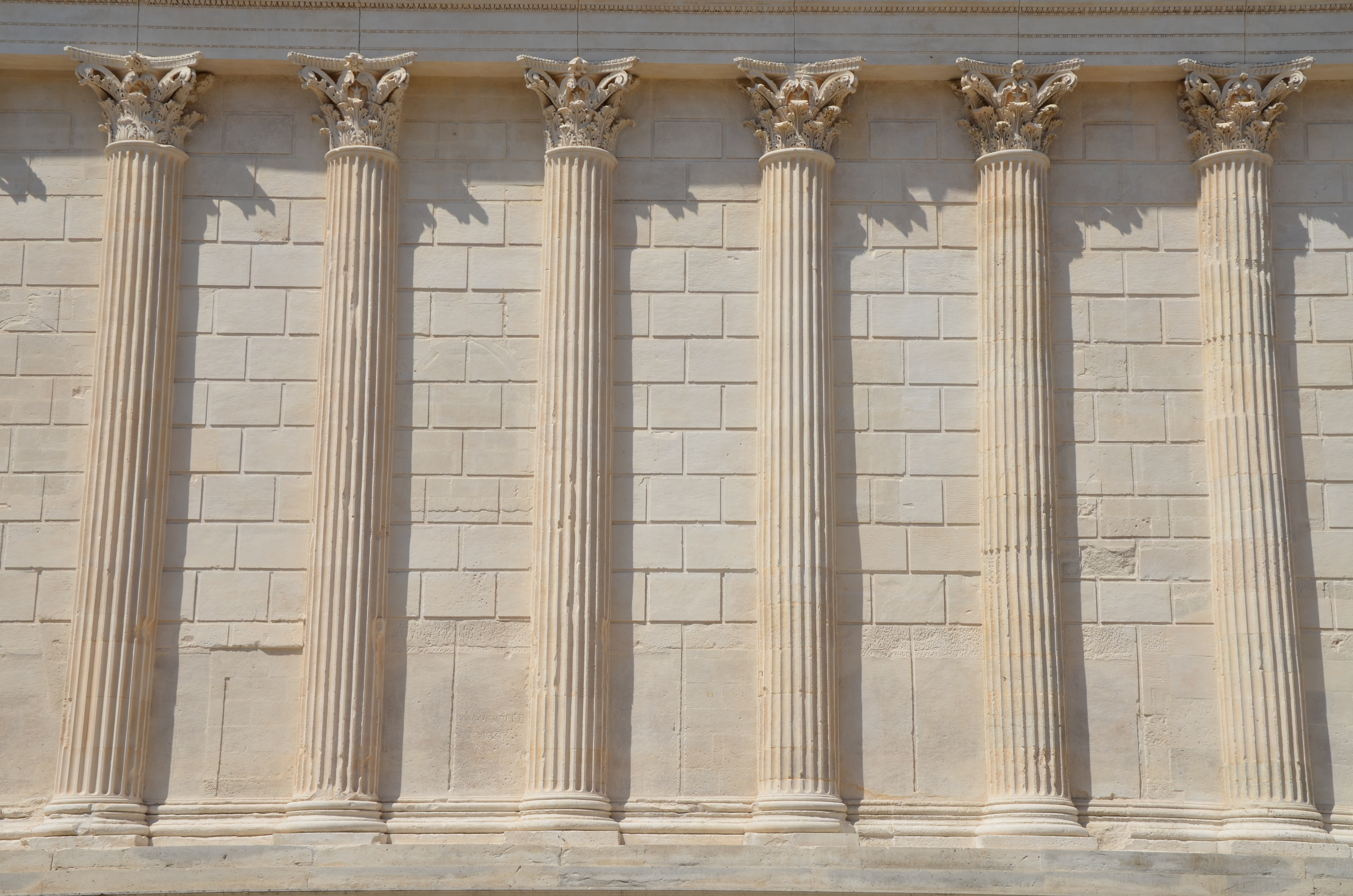
Engaged column
A column that is attached and partially embedded in the wall

Street grids, roads, sewers
Concrete
Mix of aggregate and cement
Aqueducts
arched structures that carried fresh water to roman cities and towns, utilizing gravity for flow.
Capitoleum
The primary temple in a Roman city, dedicated to the worship of the gods Jupiter, Juno, and Minerva
Castrum
A military fortification in Roman architecture, typically designed in a rectangular plan with a central street, used to house troops and provide defense.
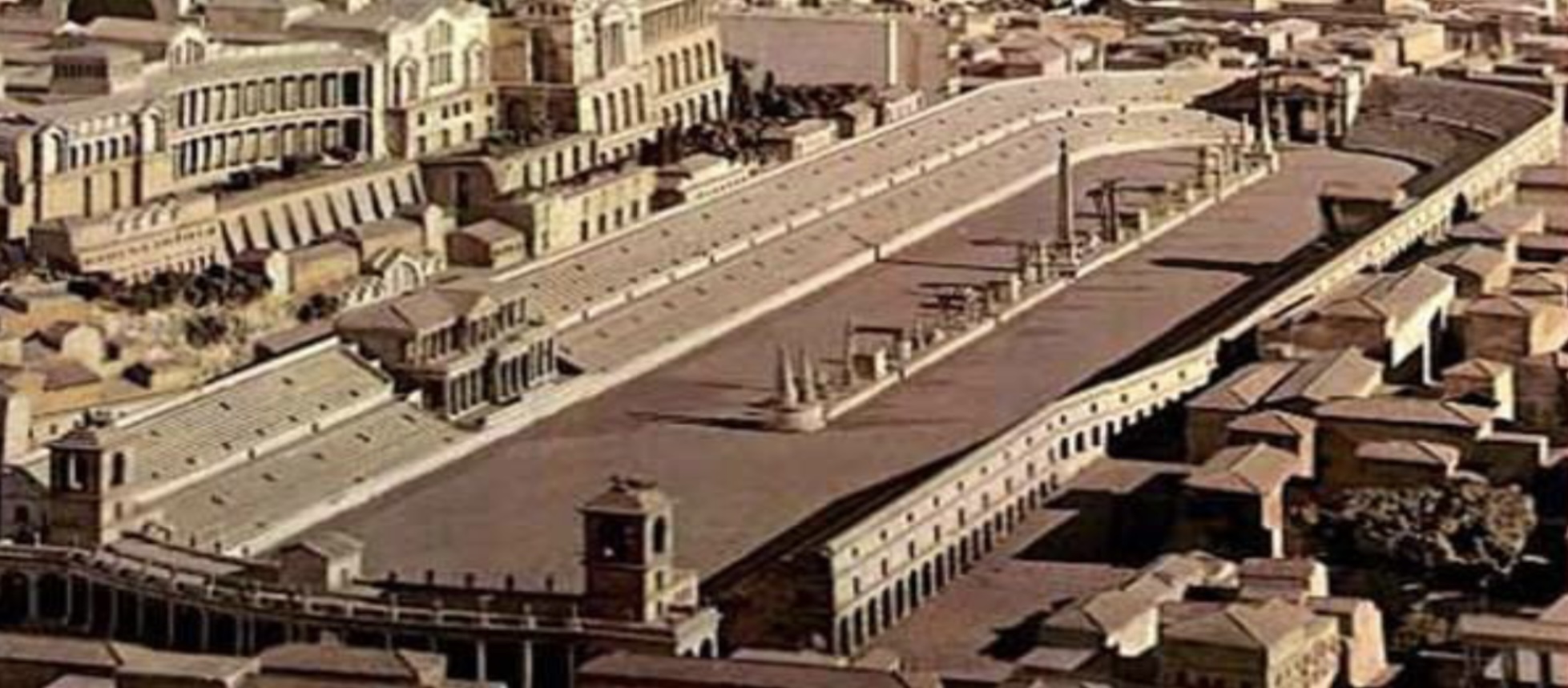
Circuses
arenas used for chariot racing
Amphitheaters
Arenas used for gladiator events
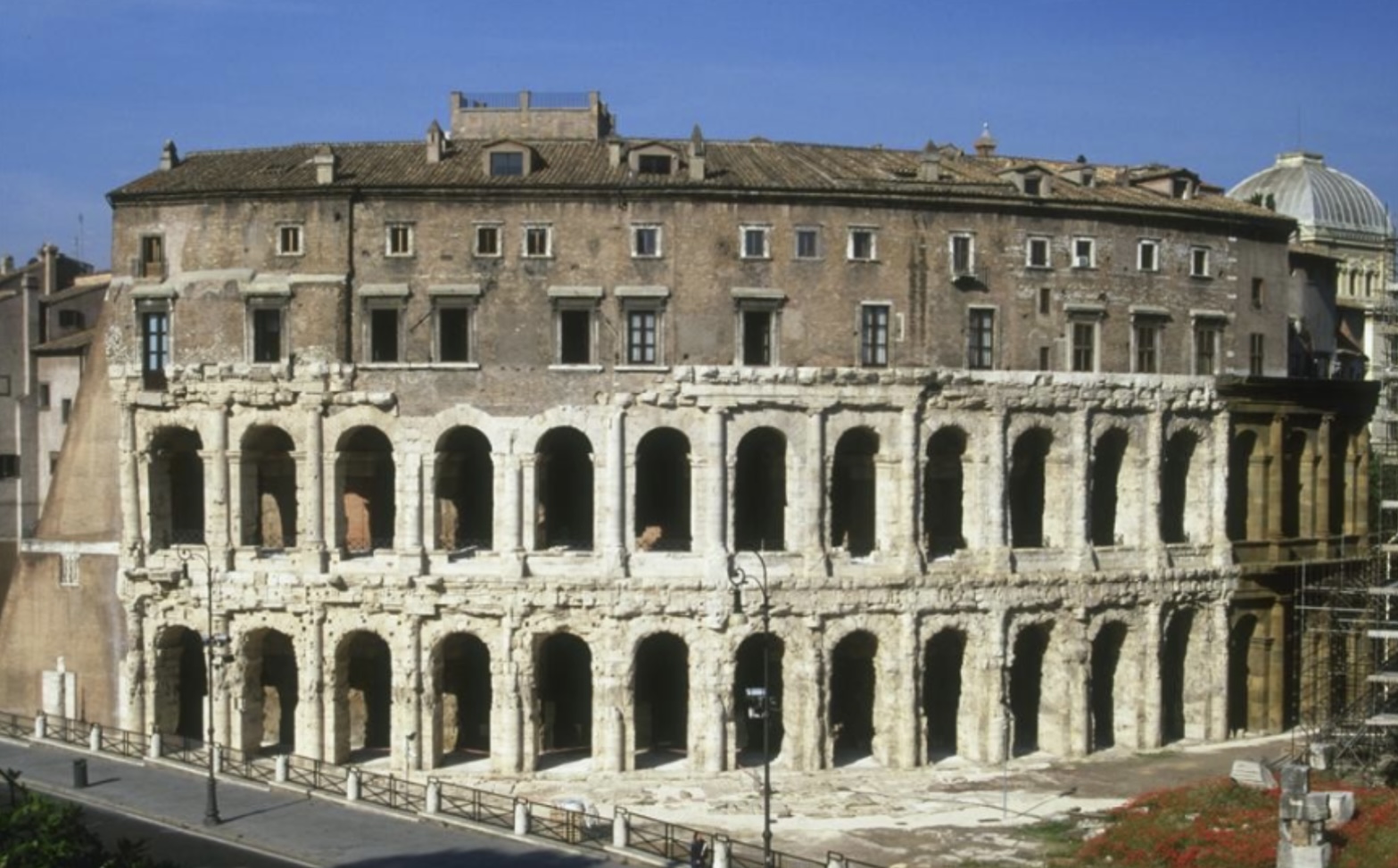
Stone theaters
ancient open-air theaters used for drama performances
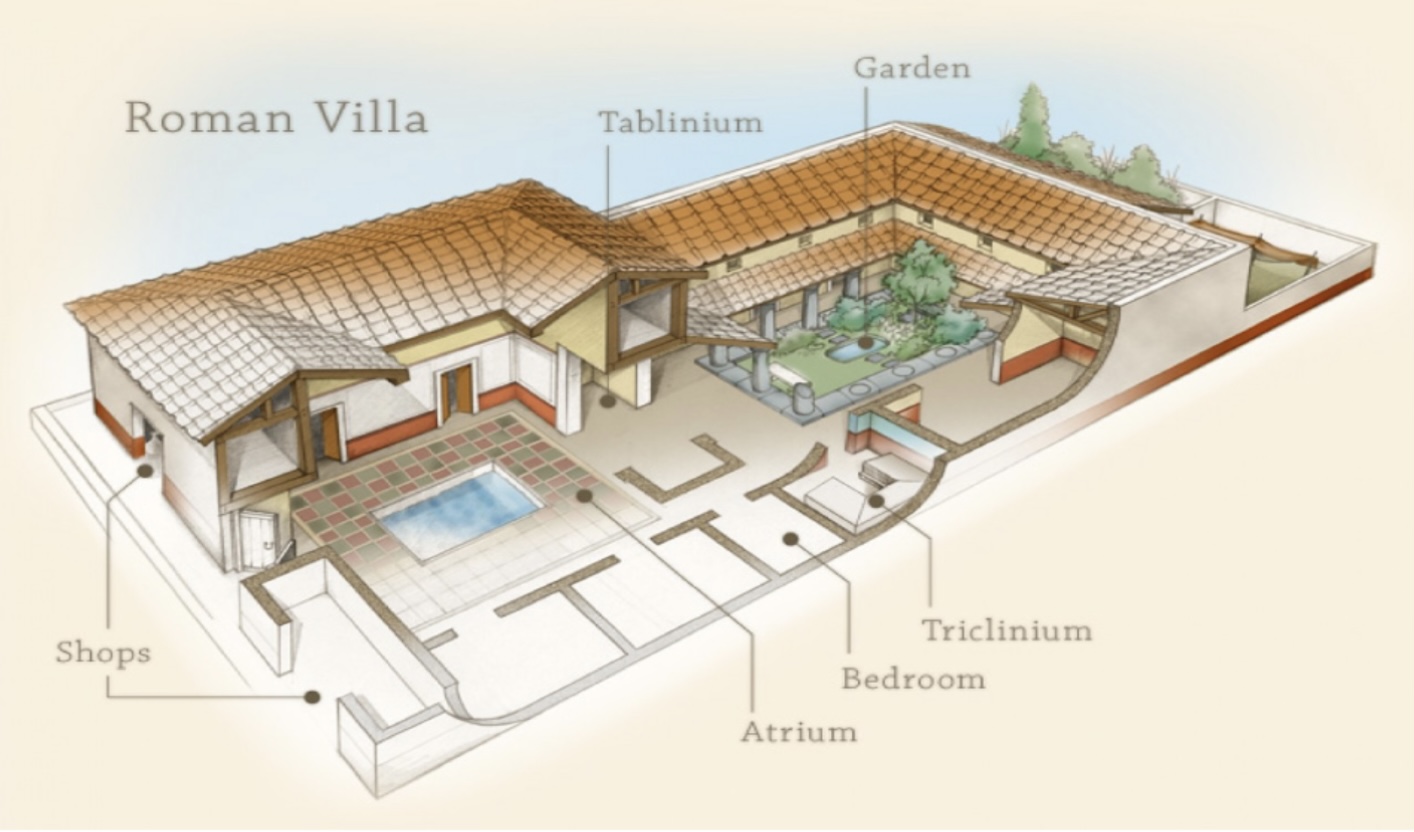
Roman villa
Atrium- This was the main room of the house, often grand and decorated with impressive features like mosaics, wall paintings, and elaborate furnishings
Triclinium- Roman dining room with couches on 3 sides of the room
Tablinum- Situated behind the atrium, the tablinum was a square room that housed the master's writing table and other business-related items. It often connected the atrium to the peristyle
And shops, a garden and bedroom(s)
Pompeii/Mt.Vesuvius
Romans were not aware mt vesuvius was an active volcano
A large earthquake in 62 ce meant many homes were being rebuilt/repainted

Herculaneum
An ancient Roman town that was buried by the eruption of Mount Vesuvius in 79 CE, preserving many of its buildings and artworks under volcanic ash.
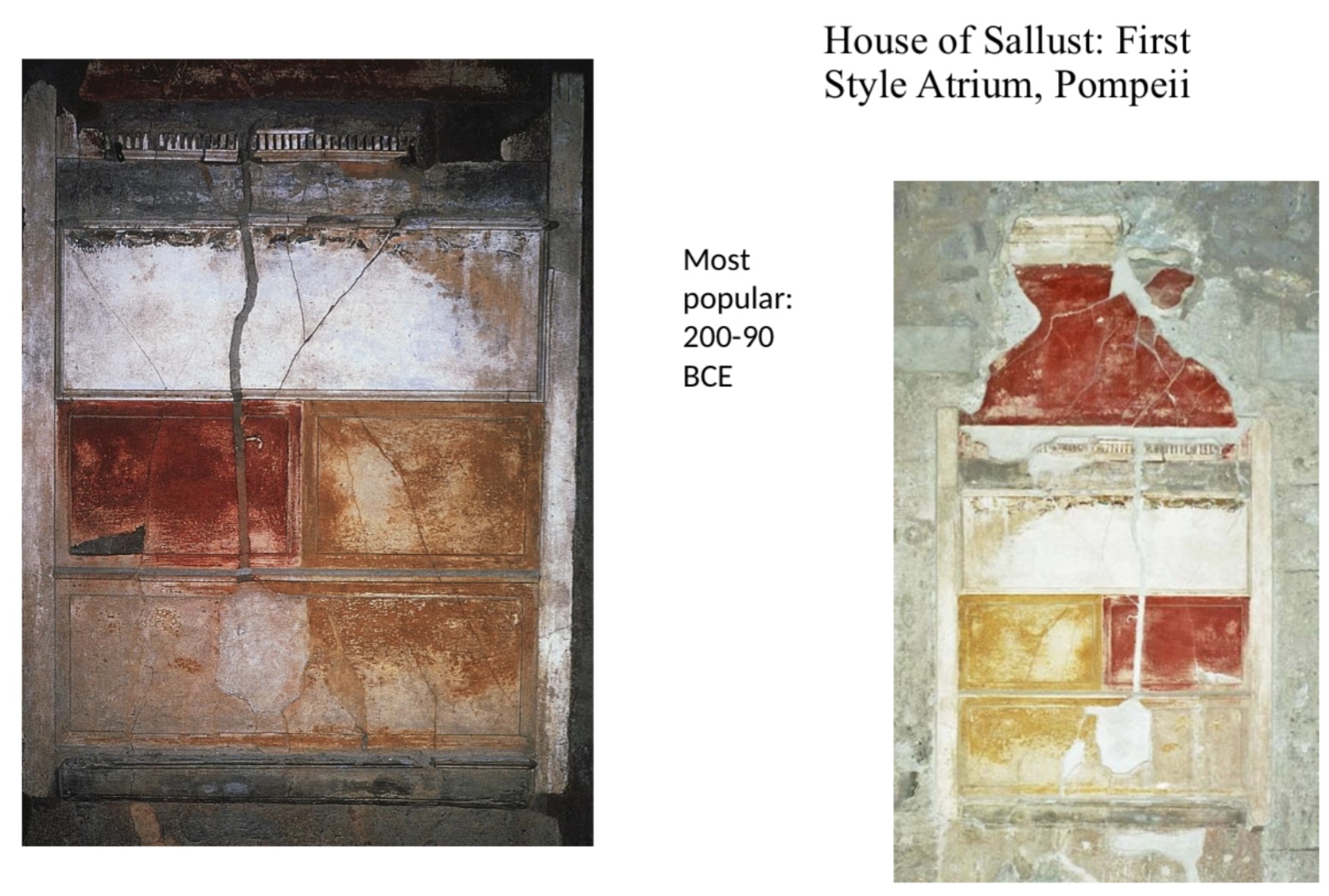
House of Sallust
Atrium
technique where the wall is painted to look like marble (FIRST STYLE)
Pompeii
90 BCE
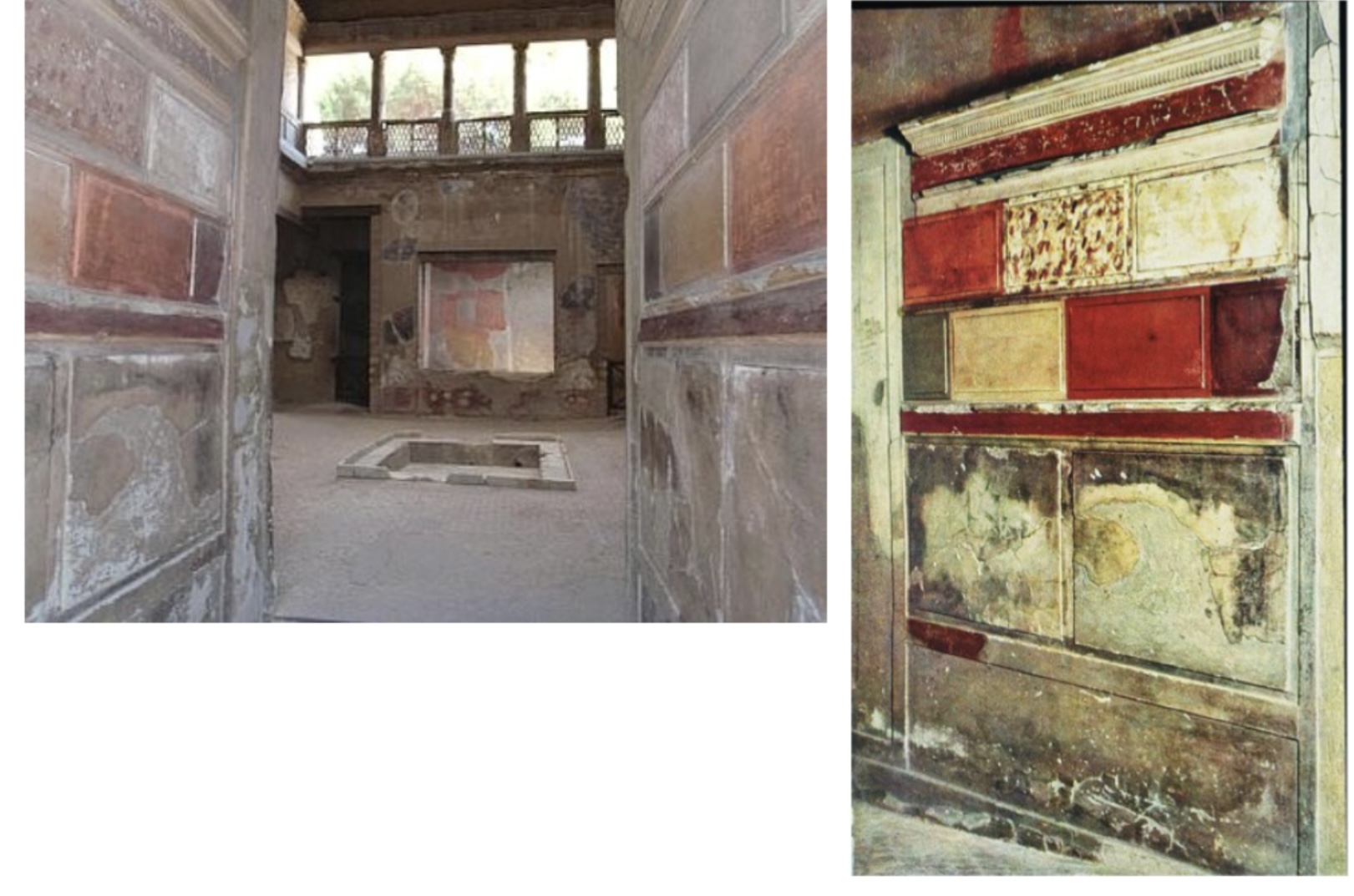
Samnite House
Ancient Roman dwelling in Pompeii
known for its elaborate frescoes and use of the First Style of painting
It reflects the influence of the local Samnite culture, characterized by vibrant colors and intricate architectural details.

House of Griffins
cubiculum
rome
2d architecture painted on the wall to look 3D (SECOND STYLE)
wall painted to look like marble
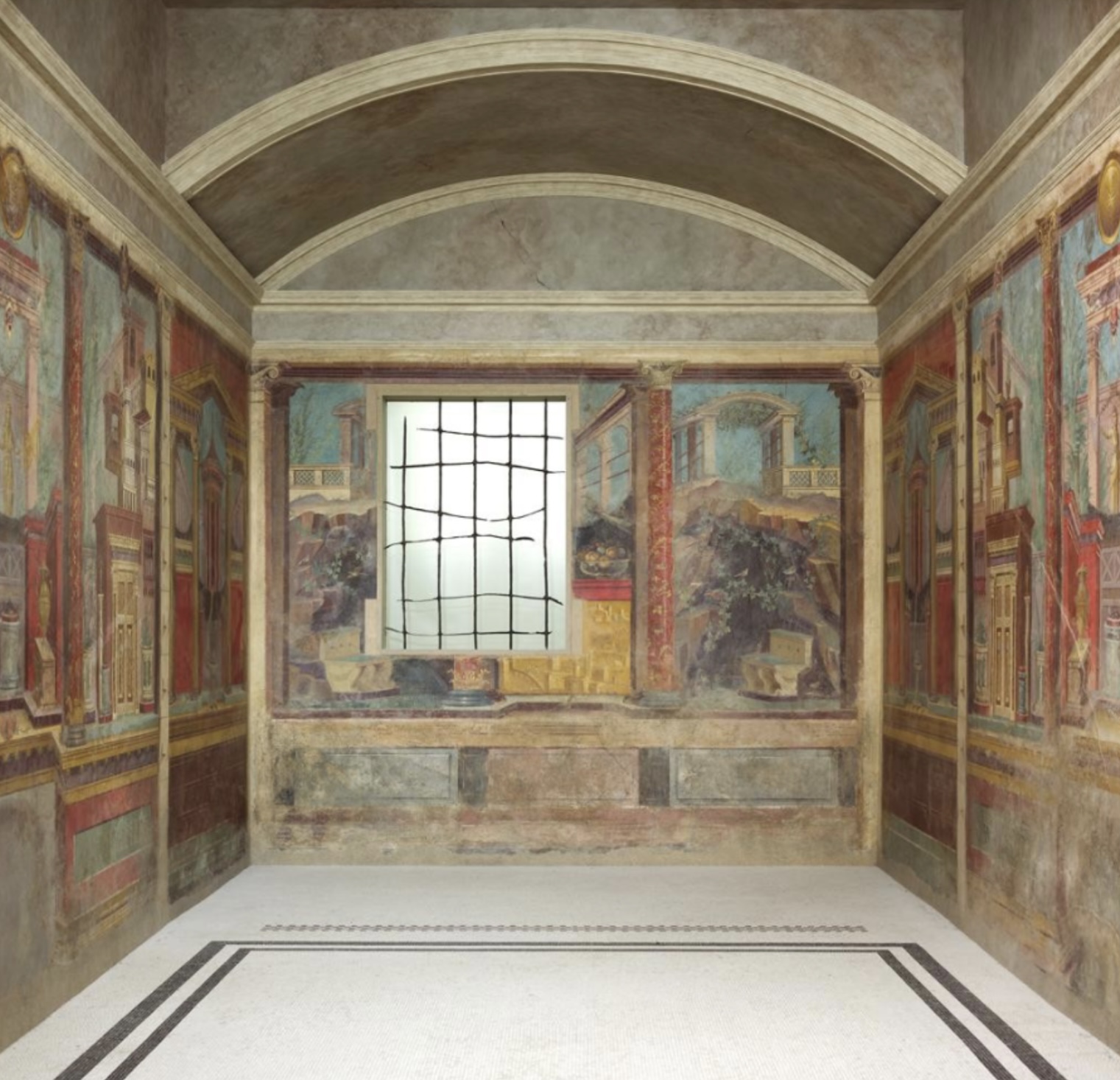
Synistor Villa
cityscapes and shrines all painted in 3D on the walls of the room
possibly commissioned to replicate stage painting (backdrops for live plays)
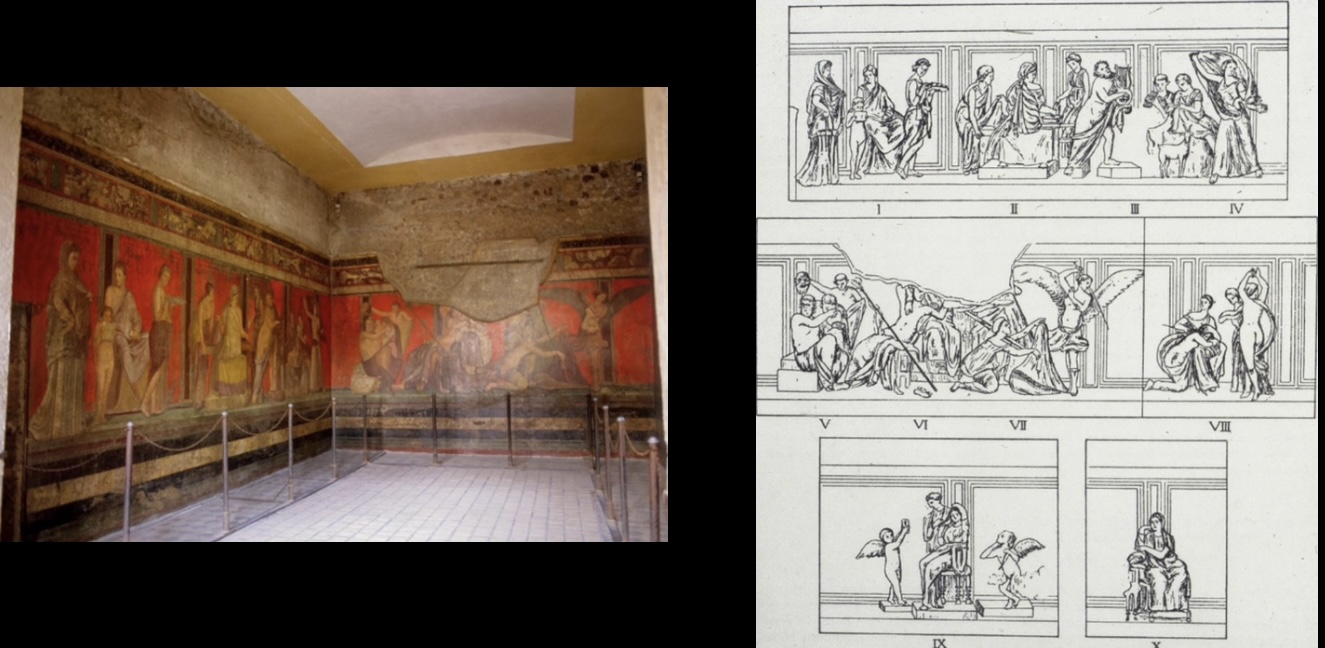
Villa of Mysteries
50 BCE
wall paintings of Dionysus (god of wine)
first scene- Roman woman watching a young boy reading from a scroll, behind the boy is a younger woman holding a scroll and to the far right is a servant woman carrying a tray
second scene- a table of women, one woman is holding the end of the table, next to her another who has her back turned is holding up a cloth and the woman on the right/back is pouring a liquid
third scene- a Silenus (follower of Dionysus) is on the left almost naked and playing a lyre, next to him are two Pans (followers of Dionysus often depicted with animals like goats) one is possibly feeding a goat with her breast and the other is playing a flute, the woman on the right has a cape and is moving towards the next scene
fourth scene- on the right is a poorly painted female kneeling, next to her is Dionysus reclining into the lap of a woman possibly drunk, to the left is an older Silenus and two young men, one is holding a theatrical mask and the the other is looking at a vase from the Silenus
Fifth scene- figure with wings and a whip, around the corner is a figure burying her head in the lap of another woman being whipped, possibly an initiation ceremony but not likely, to her right is a dancing woman
Sixth scene- a Cupid holding up a mirror to a young seated woman with a woman behind her looking at the Cupid, young woman may be dressed as a bride
Seventh scene - Domina (mistress), watching the scenes around the room, wearing a wedding ring and a veil, who she is is unknown
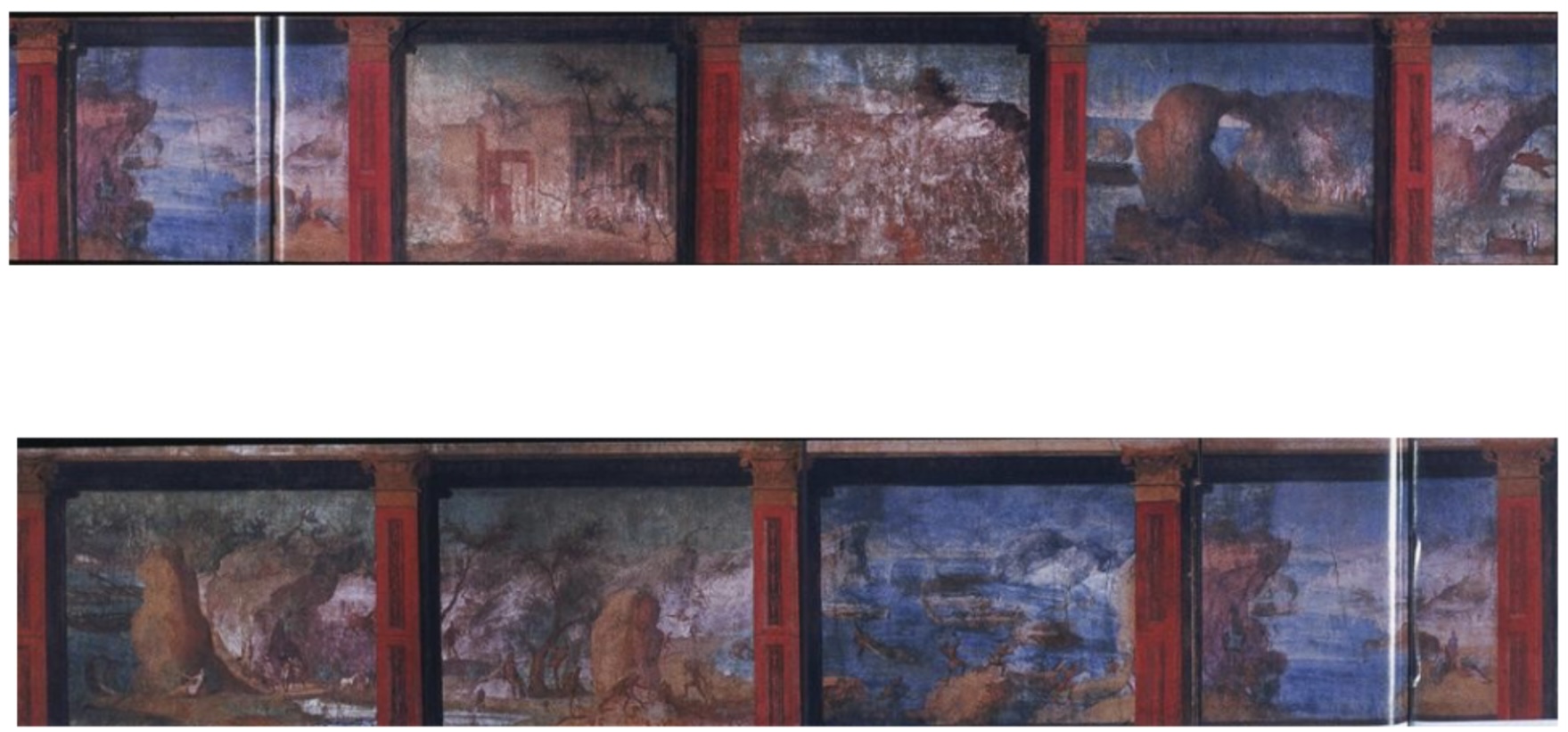
Odyssey landscapes
scenes depicting various locations from the epic poem, illustrating the journey of Odysseus
Palatine Hill, Rome
Cubiculum
Small, private room in a domus which is a larger Roman house

Cave canem
"Beware of the dog" in Latin
often used as a warning on mosaics in Roman homes, indicating the presence of a guard dog.

Alexander mosaic
pompeii
9’ wide 17’ long
Alexander is spearing Persian solidier in front of Darius
painting was made into mosaic in scale so the bottom of the mosaic is just a blank panel to fill the space
reflections painted in the shields
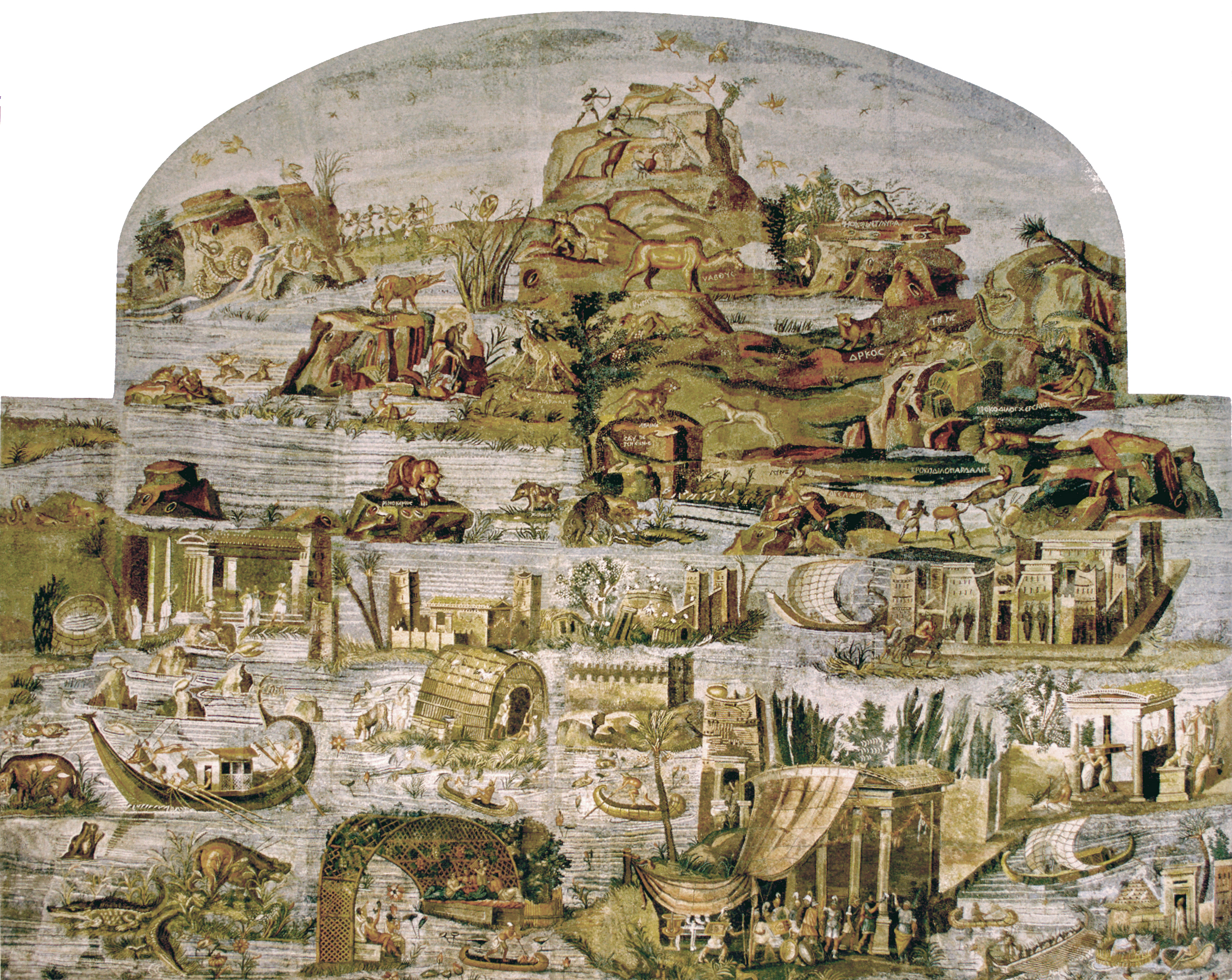
Nile mosaic
20’ wide 16’ long
atomospheric perspective
found in shrine to goddess of fortune (fortuna) in palistrina
Nile river is depicted curving but is fairly straight irl
top shows people hunting wild game with bows and arrows
animals are labeled in greek so it may have originally been a Greek painting that inspired the mosaic
middle of mosaic shows structures including a reed hut and some stone towers on small islands
all the structures in on the islands are tilted
egyptian shrine and temple with a fight scene behind it
boat is hunting hippos and crocodiles with spears
hippos and crocs represent chaos and danger in Egyptian art
bottom shows a Greek style temple with Macedonian officials
possibly Philodelphus Ptolemy

Forum of Augustus
A public space in ancient Rome built to honor Emperor Augustus, featuring a temple dedicated to Mars and the Forum of Julius Caesar.
It served as a political and social center for Romans, showcasing monumental architecture and important artworks.
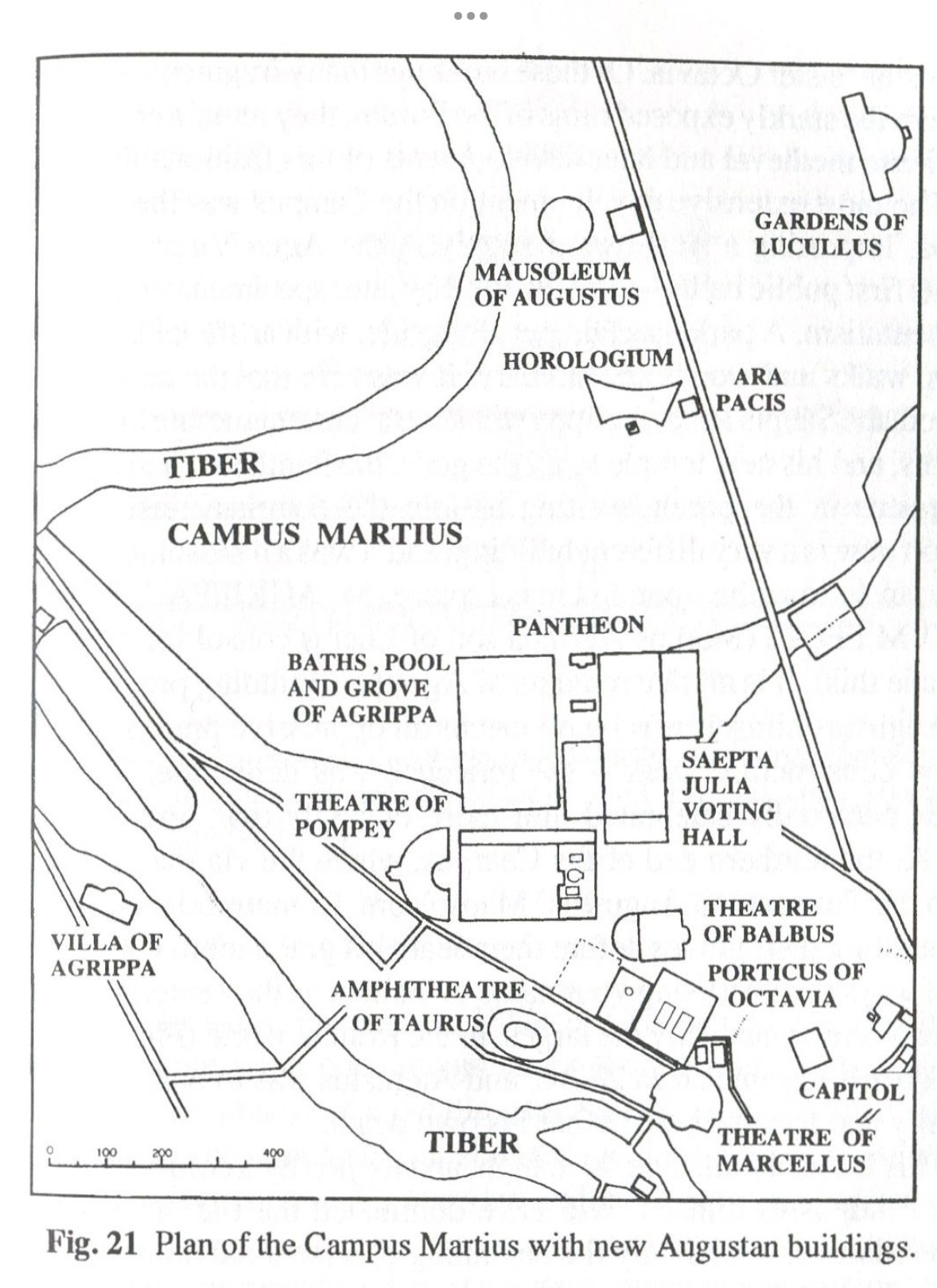
Campus Martin’s
An ancient public park in Rome used for various activities, including athletic competitions and military training, as well as a space for social gatherings and processions, featuring gardens and temples.
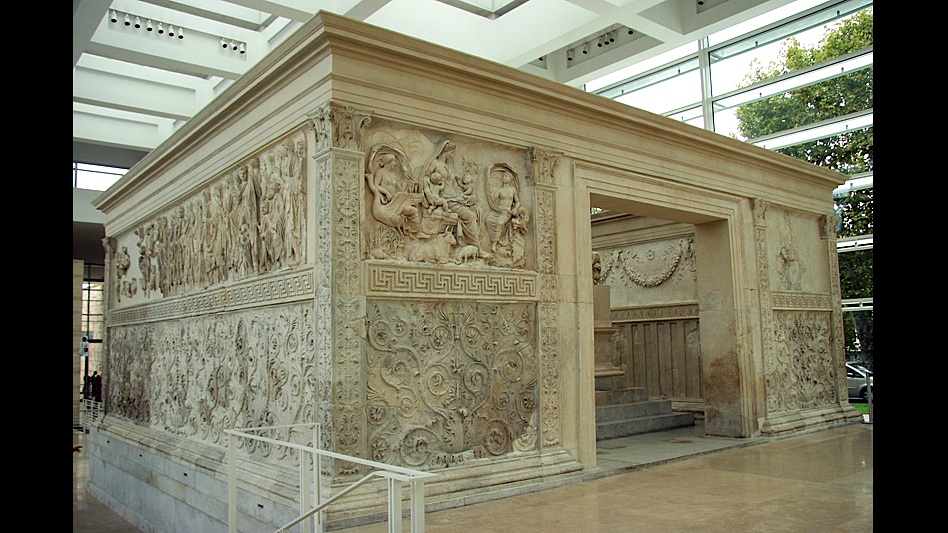
Aria Pacis
The better preserved panel of the east wall depicts a seated female figure who has been variously interpreted as Tellus (the Earth), Italia (Italy), Pax (Peace), as well as Venus.
The panel depicts a scene of human fertility and natural abundance. Two babies sit on the lap of the seated female, tugging at her drapery. Surrounding the central female is the natural abundance of the lands and flanking her are the personifications of the land and sea breezes.
the theme stressed is the harmony and abundance of Italy, a theme central to Augustus’ message of a restored peaceful state for the Roman people
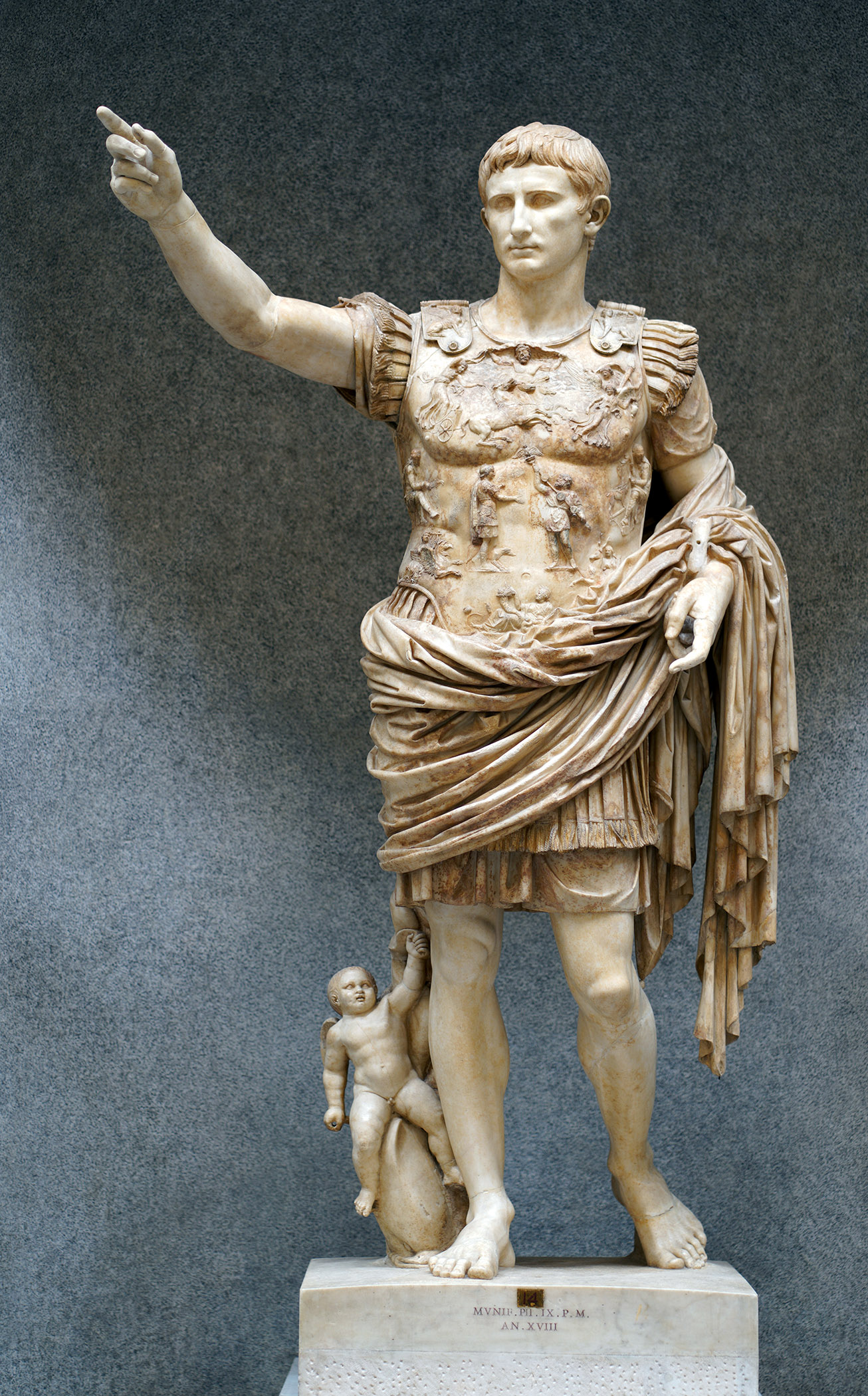
Augustus of Prima Porta
A statue of Emperor Augustus, portraying him in military attire and idealized form. It symbolizes his role as a leader and a divine figure, emphasizing Augustus' power and the peace he brought to Rome.
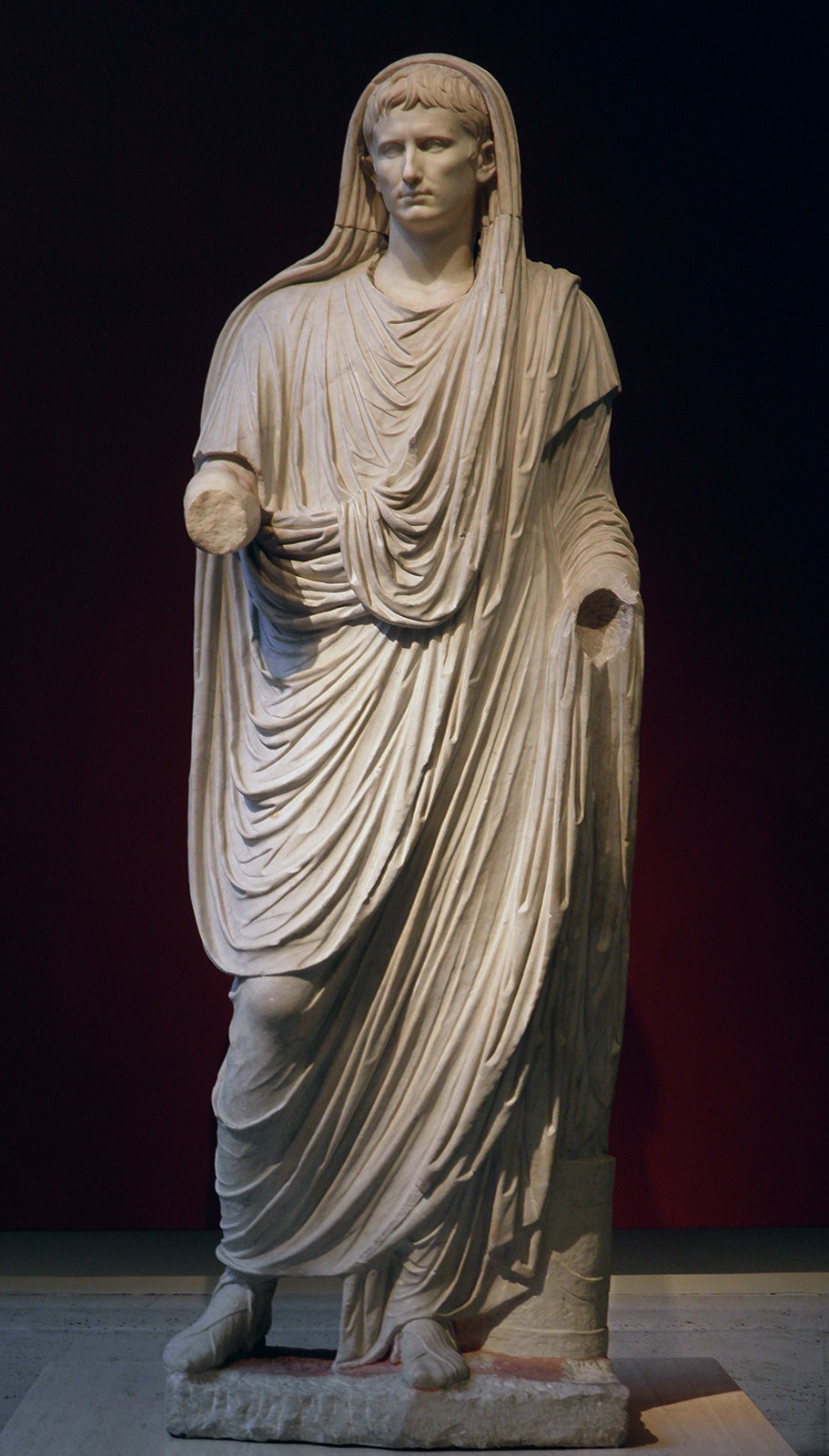
Augustus as Pontifex Maximus
6’10
Top part is greek marble, bottom part is italian marble
Augustus has his head covered signifying a religious context
Story says he became a priest without qualifications
Augustus as Pontifex Maximus was a title held by Emperor Augustus that signified his role as the chief priest of Roman religion. The statue symbolizes his religious authority and connection to the divine
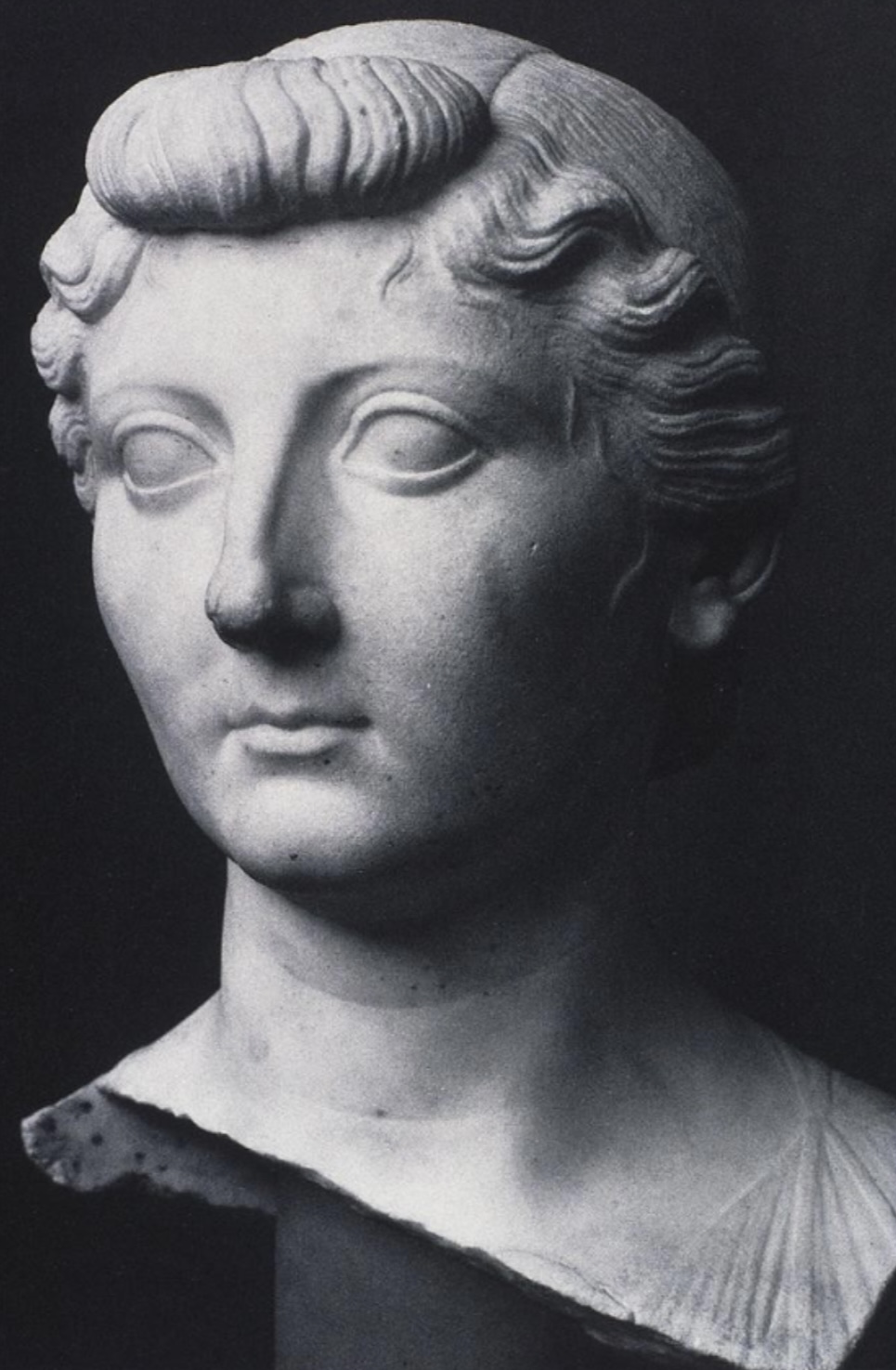
Livia bust
34 cm
Smooth skin, oversized eyes
marble bust of Livia Drusilla, wife of Augustus
idealized features, highlighting her status and beauty.

Maison Carrée, Nimes
19 BCE
44’ x 86’, 30’ tall
Corinthian columns, limestone
Capitals of columns have a lot of foliage as does the frieze
acanthus
Originally dedicated to augustus’ nephews who died before they could take power
After they died they were dedicated as human-gods
Coffered porch ceiling
Carved, inset pattern on the stone ceiling tiles
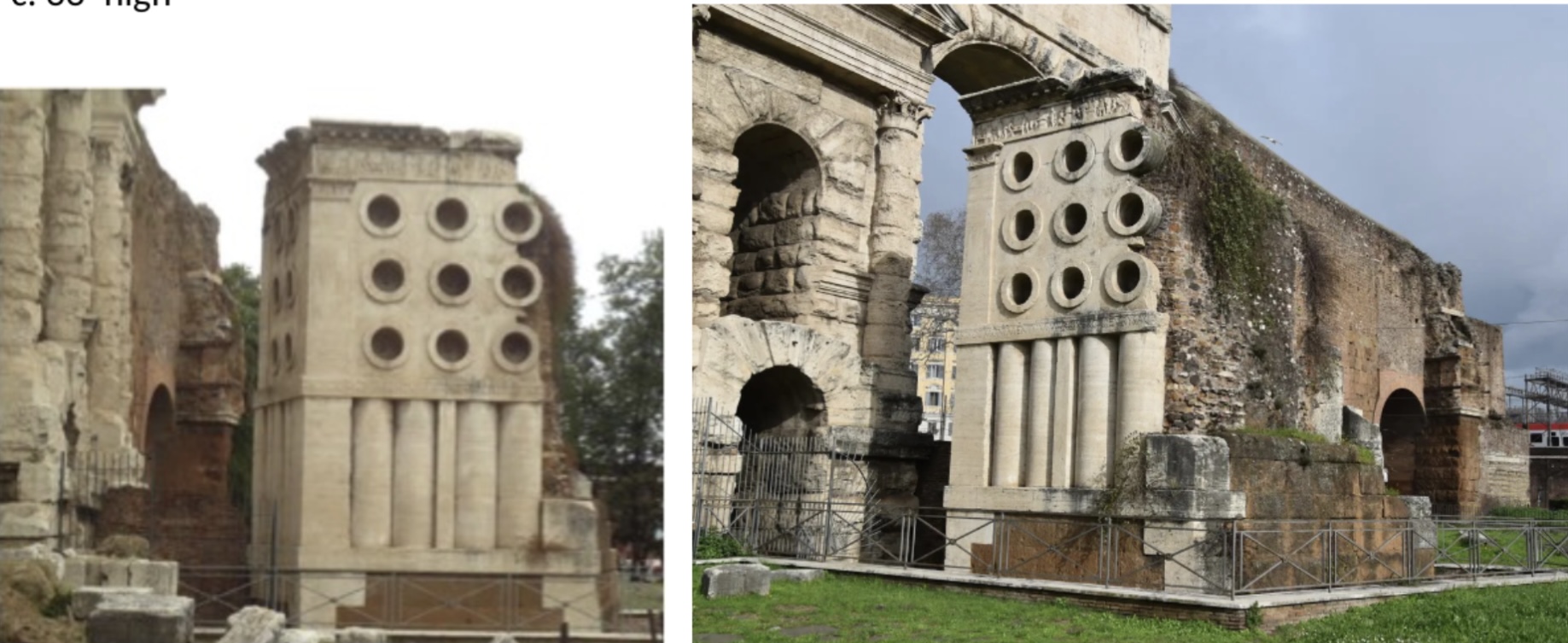
Tomb of Eurysaces
50-20 BCE
33’ tall
Concrete covered with limestone
Eurysaces is the architect
Possibly a freed slave, had no fathers name
Possibly a baker with a contract with either the roman army or city officials, tomb cost a lot of money to produce
Tomb is surrounded by city walls and aqueducts which is likely why it survived
9 holes are theorized to represent a kneading machine
Top of the tomb shows industrial baking in bas relief
Marble reliefs found nearby possibly represent eurysaces and his wife
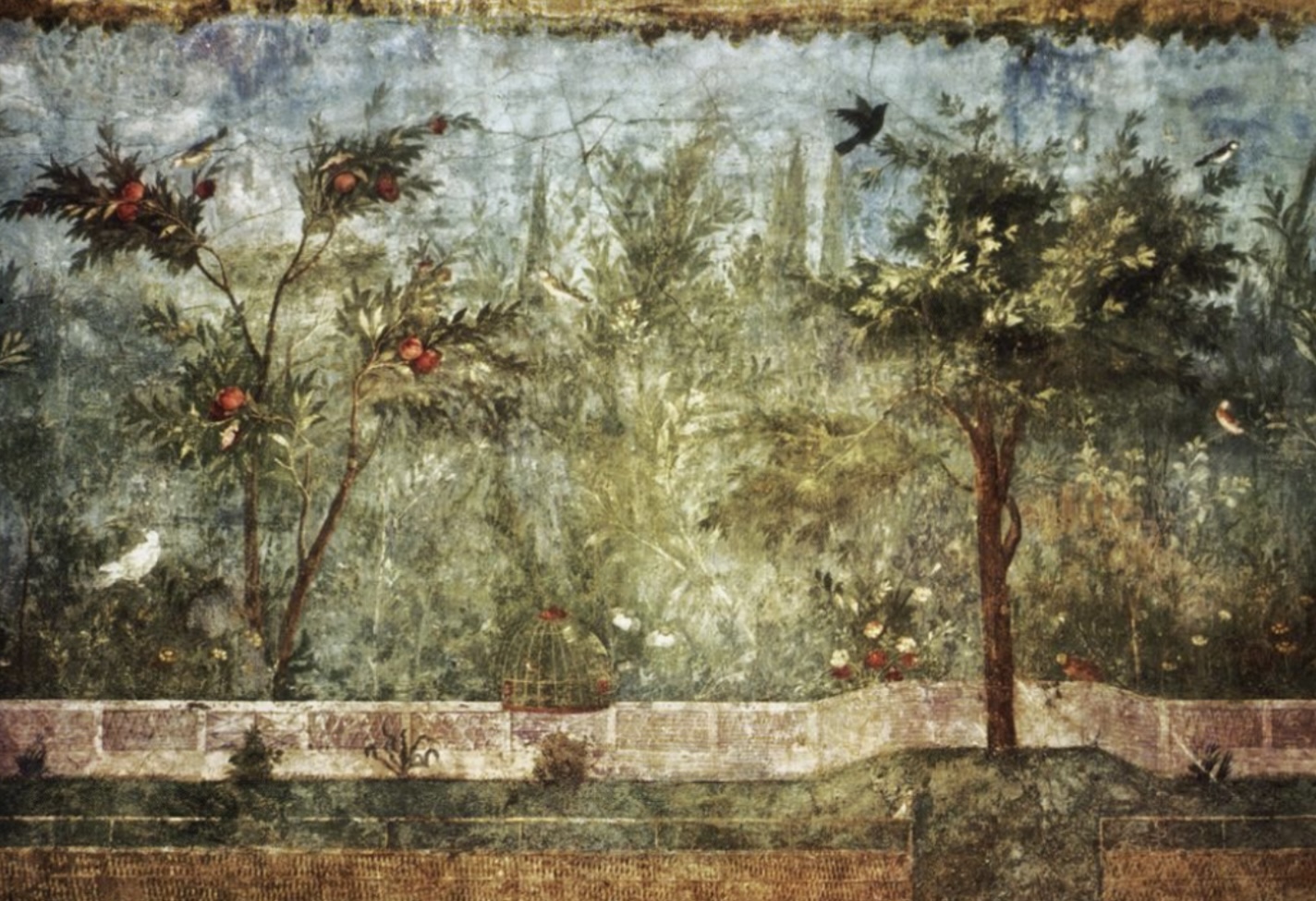
Livia’s garden room
1st century bce
2nd style
Atmospheric perspective
Landscape is not naturalistic/wild, implying its a garden or orchard
Fruits, flowers and birds all depicted but not botanically accurate
No humans or buildings
Possibly used for religious purposes, no windows or other archetecture that suggests it was a sitting room for example
Paintings are on all four walls and must have been very expensive to commission

Villa Farnesina
Second style painting
Possibly augustus second in command and husband of julia
Painted architecture and a podium shelf, painted marble, scenes out windows and framed pictures
Window scene is mythological (dionysus and his mother), framed pictures are more simple (girl pouring perfume)
20 bce
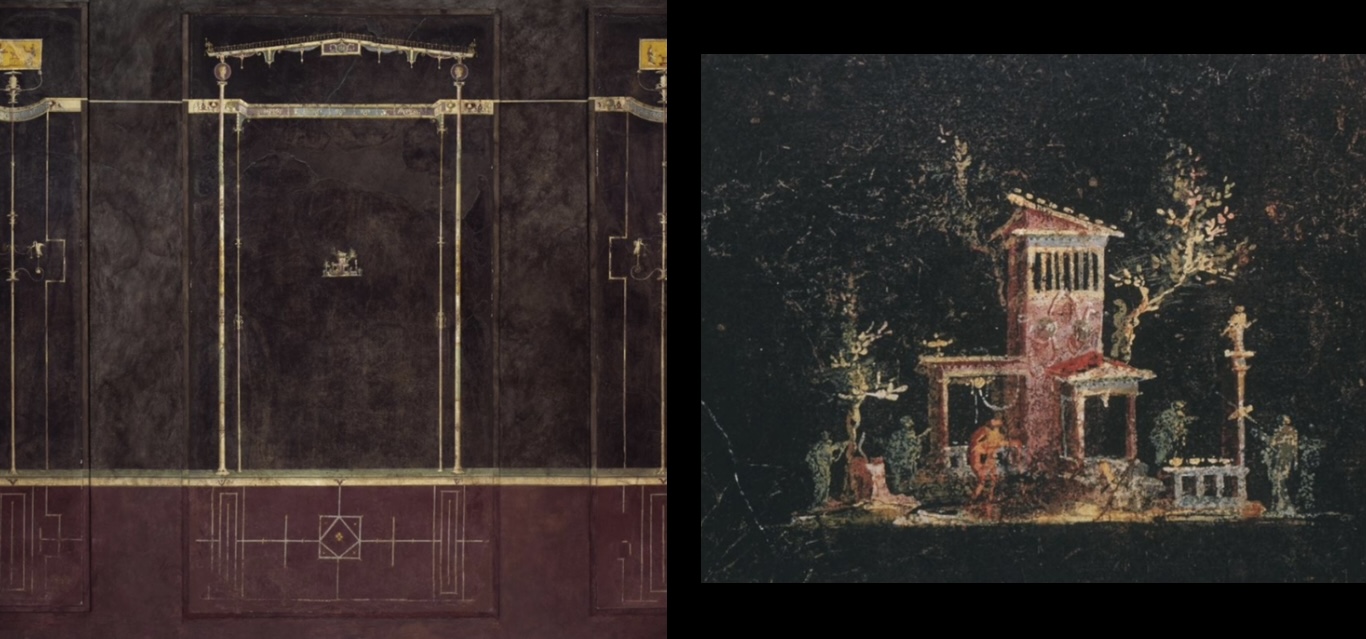
Boscotrecase
Third style wall
Painted platform is very narrow
Very thin columns and pediments
Comedic take on second style
Floating sacro-idyllic scene
Aediculum
A small shrine or temple structure used in ancient Roman architecture, typically housing a statue or other significant object of veneration.

Sacro-idyllic
Pertaining to sacred and idyllic scenes, often depicting tranquil landscapes with religious or mythological significance.
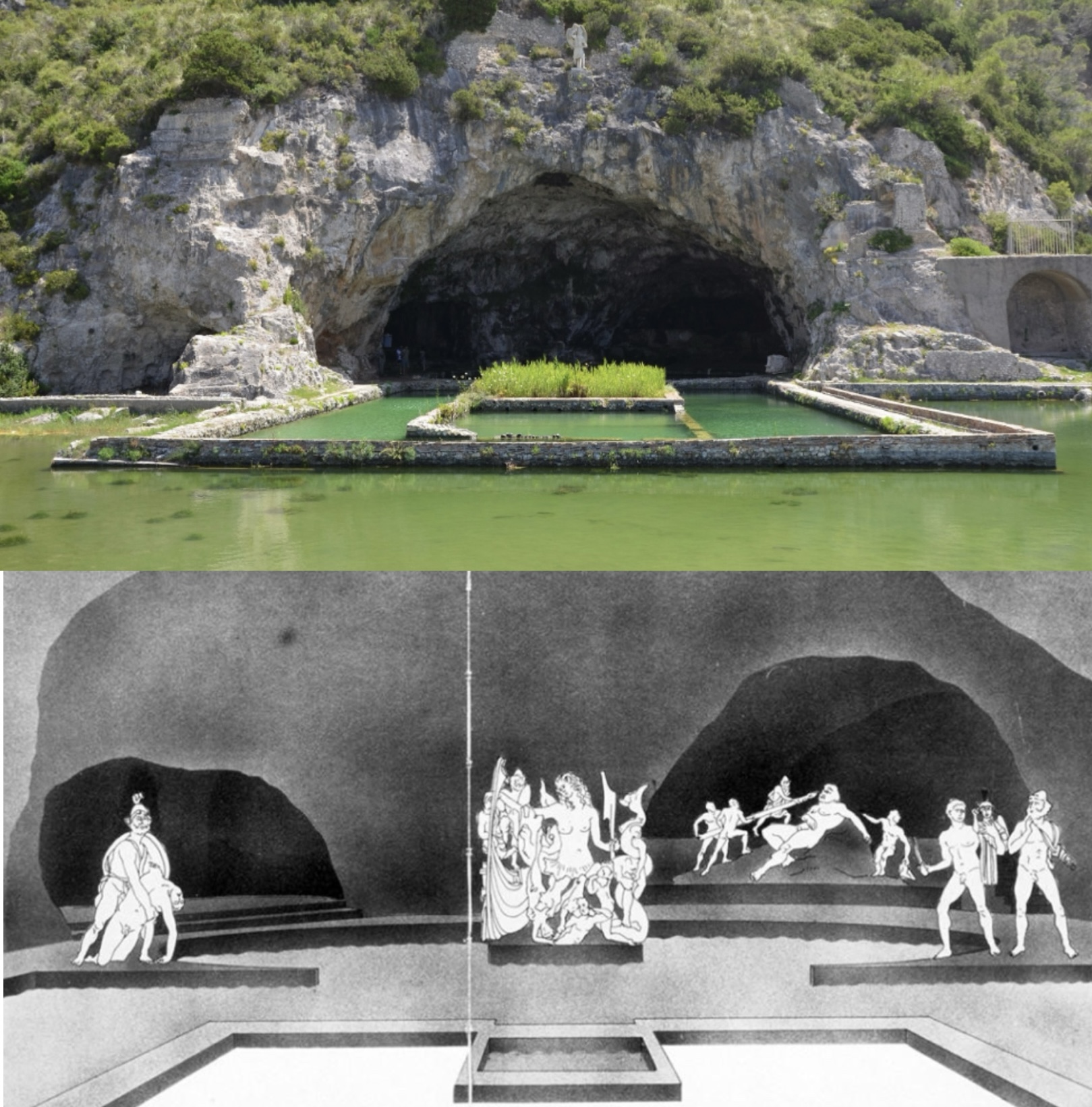
Grotto at Sperlonga
Found by surveyers exploring a highway route
Design has an outdoor pool with a little dining room in the middle, guests could look into the cave which was filled with a bunch of statues
The statues were on artificial islands within the cave
On the hill above the cave is a villa
Thought that this couldve been tiberius villa
Roof of the cave collapsed crushing the statues
Polyphemus statue showing odyssey story
Scylla’s hand from odyssey story (whirlpool)
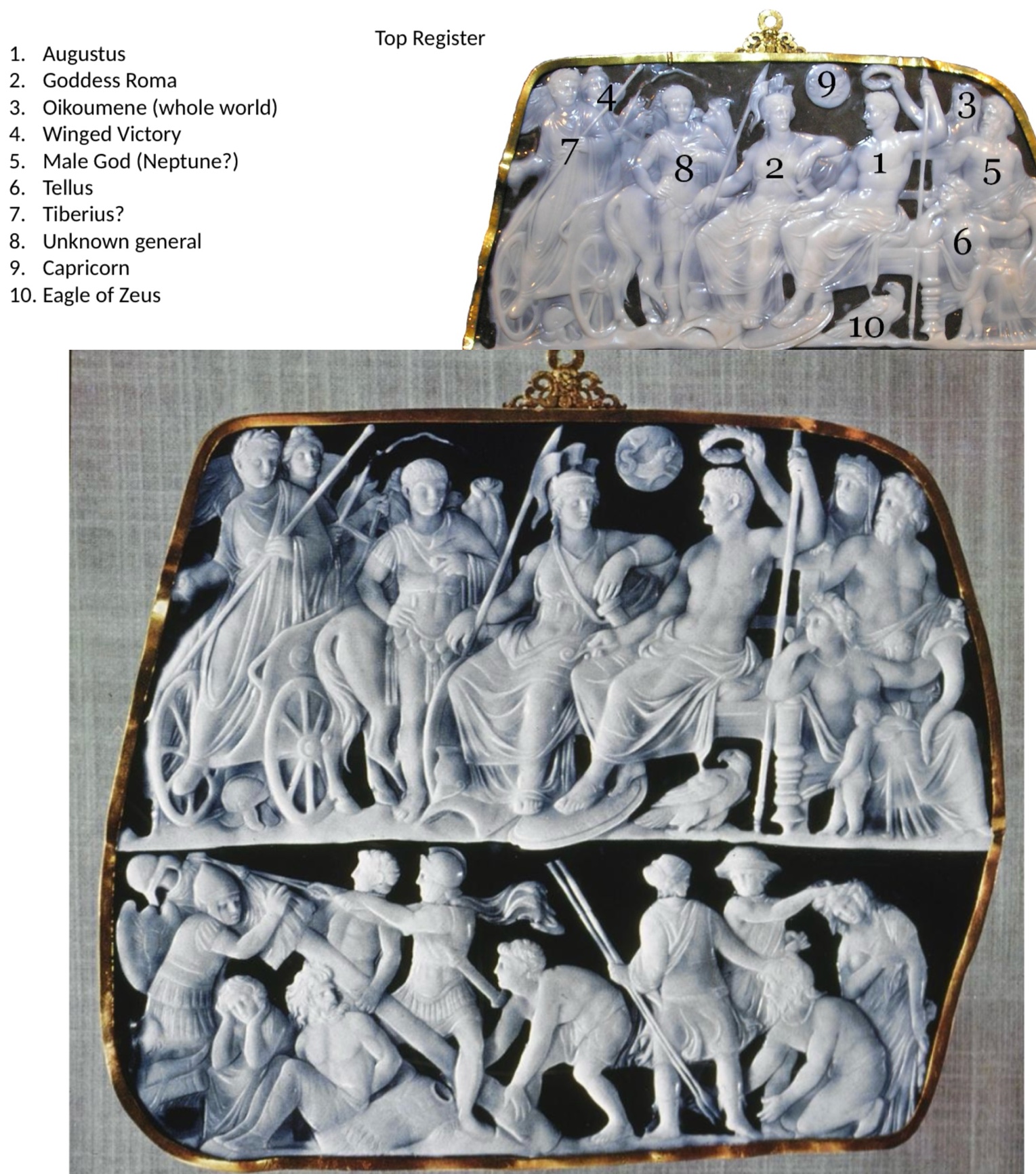
Gemma Augusta
“Augustin gem”
Cameo - carve scene into multicolored layered rock to create silhouettes and a background
7.5x9”
Two registrars and groundlines
Top
Possibly depicting dead augustus (no shoes, naked, holding curved object)
Man on the left in chariot may be tiberius
Disc represents capricorn, augustus birth sign
Also goddess victory, roma and earth
Bottom
Roman depiction of battle victory
Hanging the armor of a killed enemy on a log and erecting it as a trophy
Two figures under the log are assumed to be captured peoples
One woman on the right is being captured by her hair
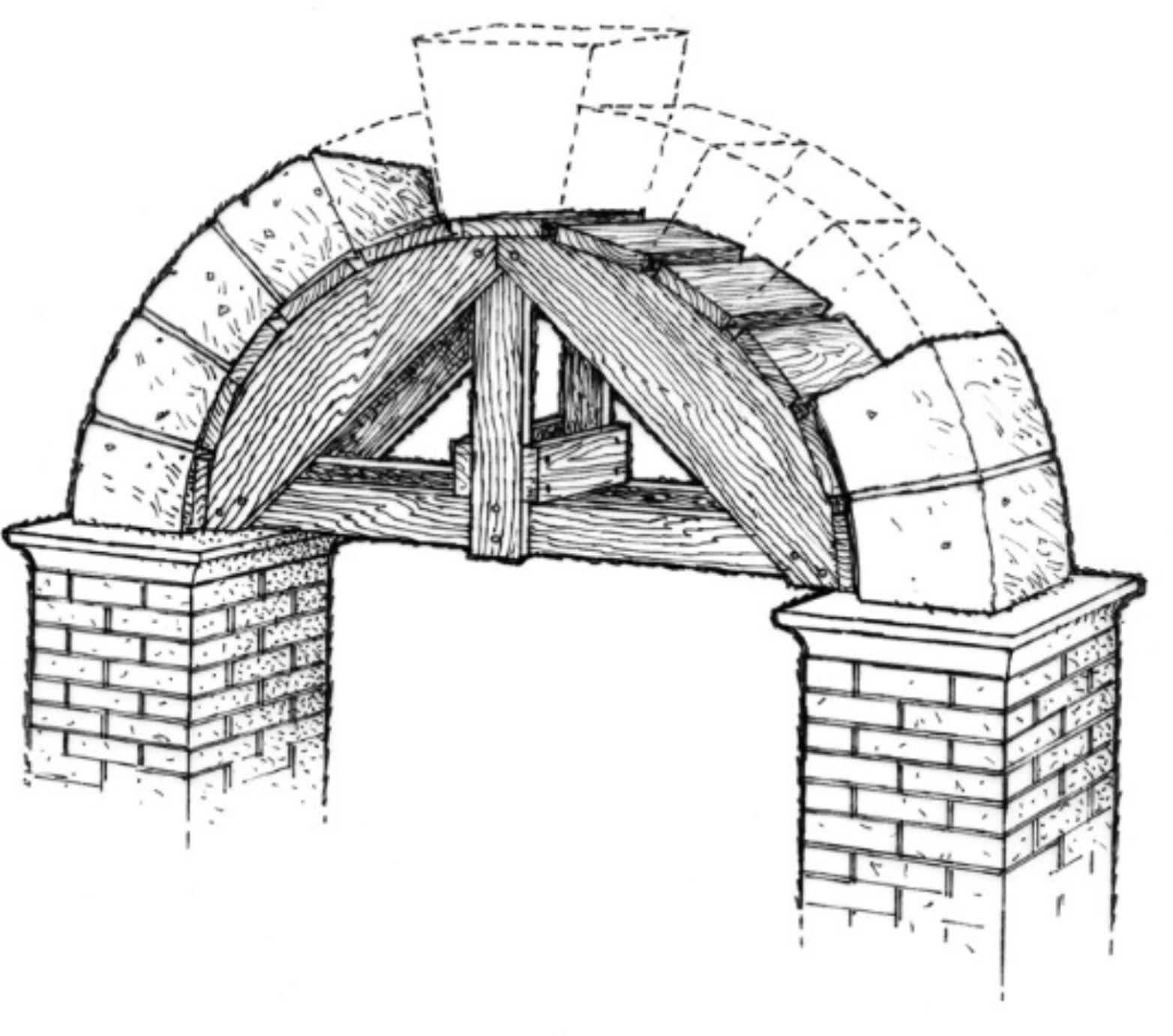
True arch construction
A method of building using a curved structure that spans an opening and supports weight above it, commonly seen in Roman architecture. This technique revolutionized the stability and durability of structures such as aqueducts and bridges.
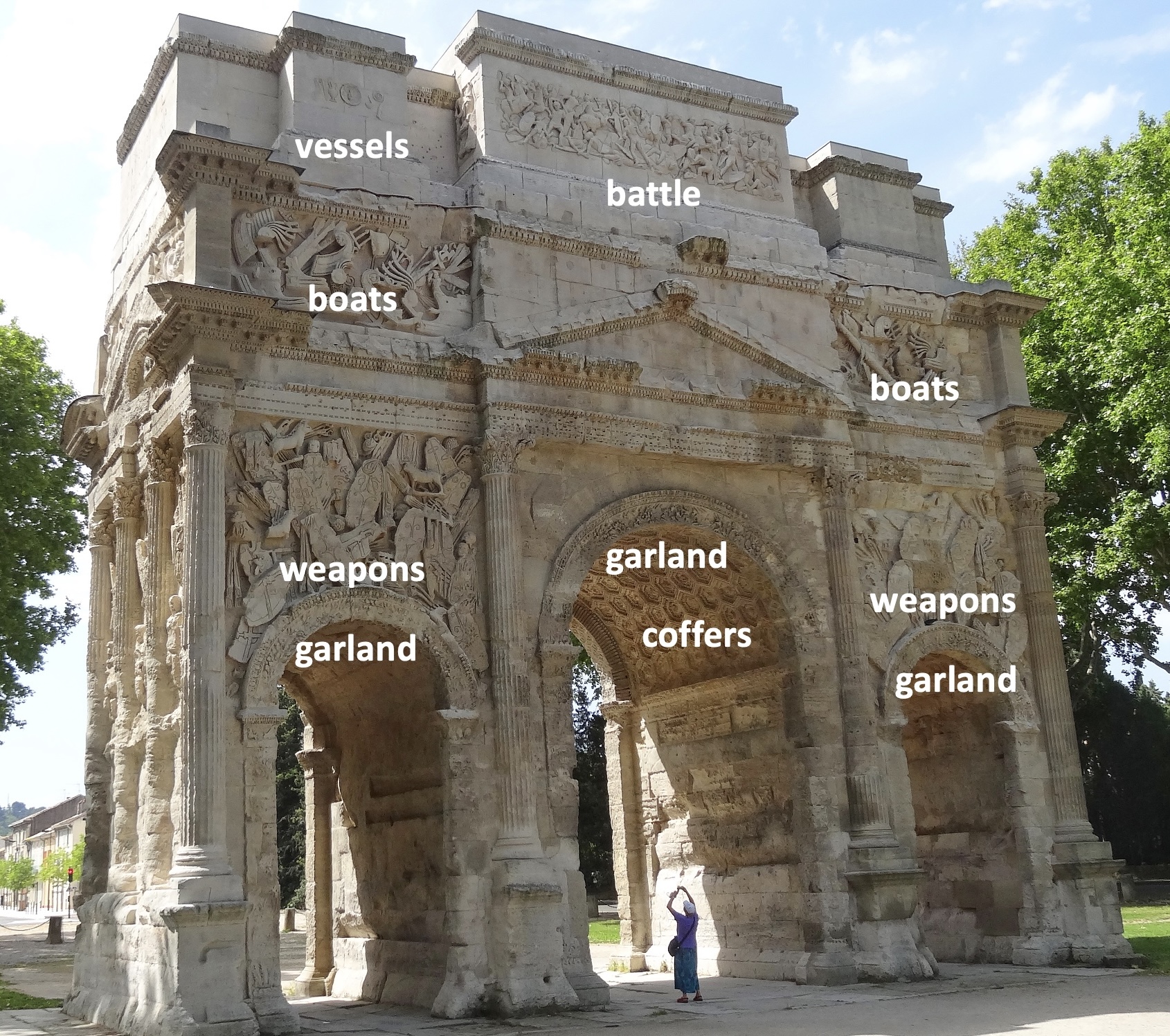
Arch at orange
An ancient Roman arch located in Orange, France, known for its impressive preservation and elaborate relief sculptures that commemorate military victories.
A triumphal arch is a free-standing monumental structure in the shape of an archway with one or more arched passageways, often designed to span a road, and usually standing alone, unconnected to other buildings.
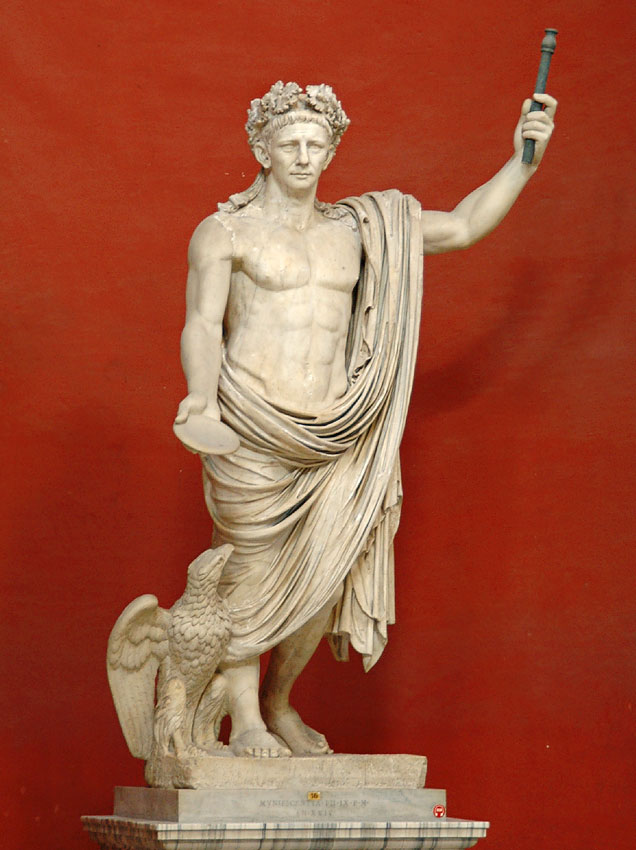
Claudius as Jupiter
8’4
Found in lanuvium
Wreath depicting jupiter
Bare feet signify religious act
Profile head, frontal body
50 CE
A monumental statue representing the Roman Emperor Claudius as the god Jupiter, showcasing his power and divinity.
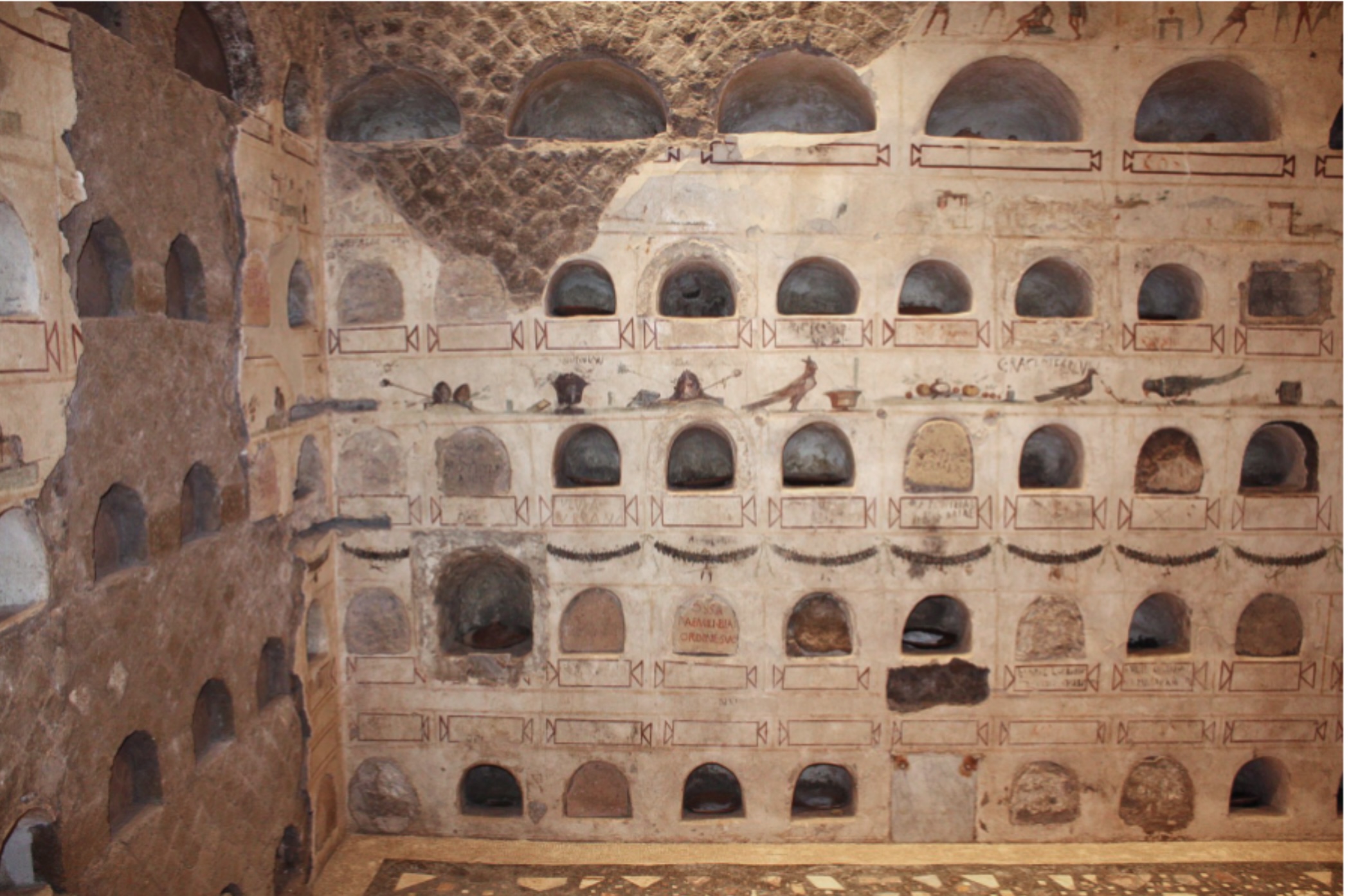
Columbarium, Rome
Tomb with small nieches people could pay to have their ashes put in
Arches made of stone
Many had portraits of themshelved painted in their niche
that served as a final resting place for the deceased, typically used by families. These structures often featured decorative elements and were designed to showcase the identities of the individuals interred within.
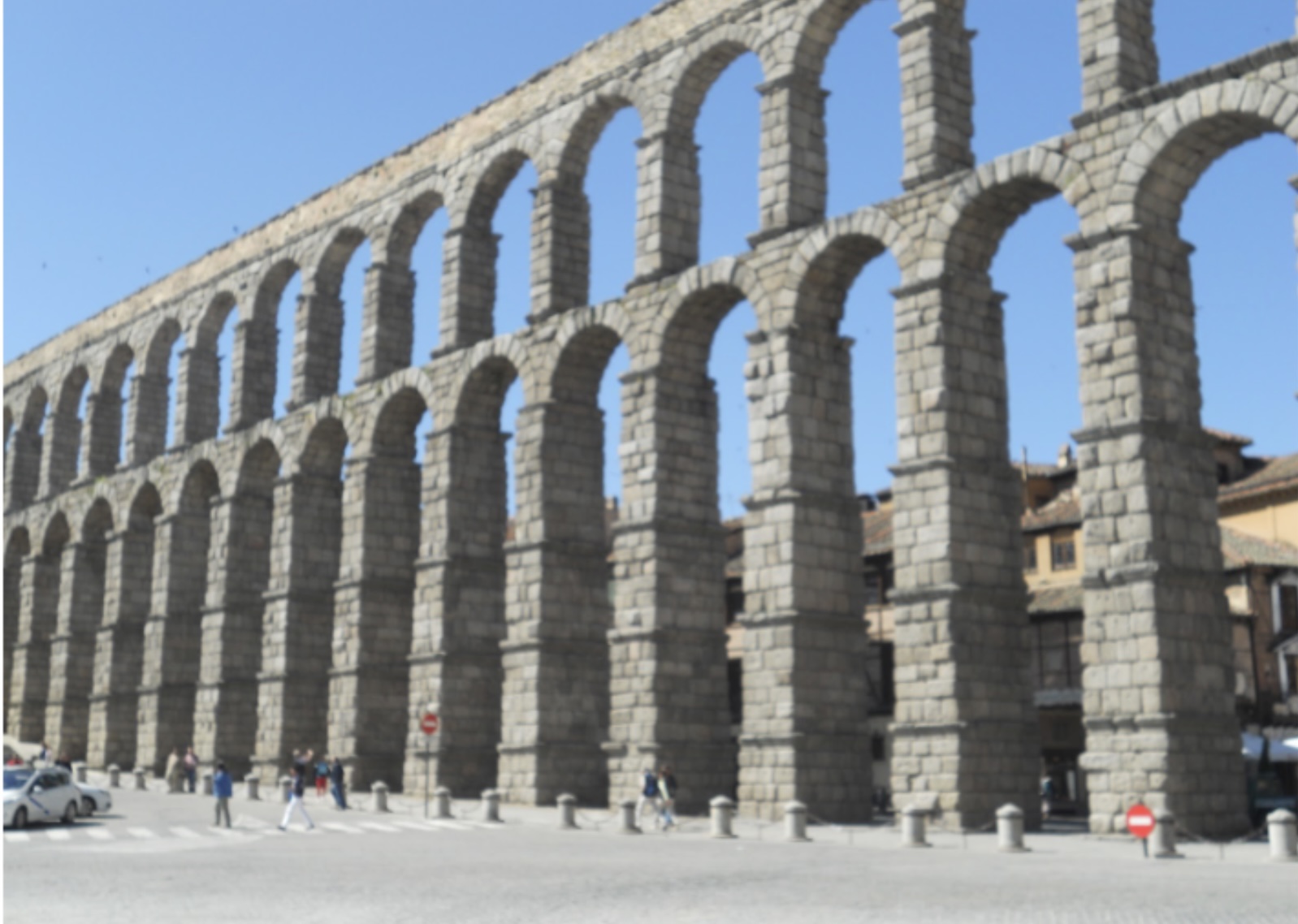
Aqueduct, Segovia
A remarkable ancient Roman aqueduct located in Segovia, Spain, known for its impressive arches and engineering marvel that supplied water to the city.
This aqueduct features a series of monumental stone arches, constructed in the 1st century AD, and is a testament to Roman engineering, remaining fully functional for centuries in transporting water.

Pont du gard
50 CE
162’ high, 900’ long
Central arches are bigger with four smaller arches above them
Made with local limestone, no mortar
Location and unfinished brick suggests that the romans did not find them as spectacular as we do
Supplied nimes until 400-500 CE
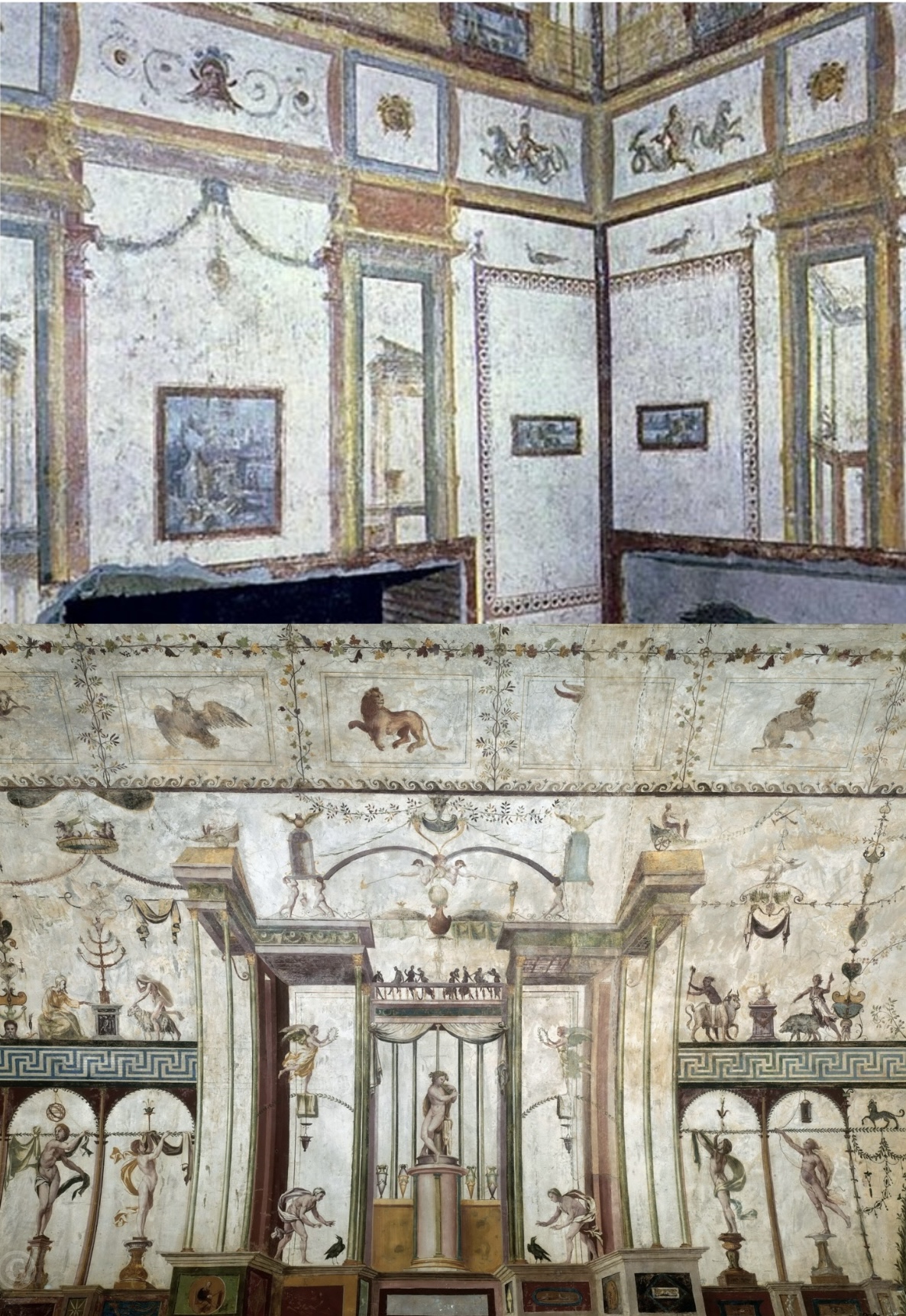
Domus Aurea
Made up of multiple buildings
Concrete was covered with sheets of gold, ivory or paintings and had embedded jewels
Wall paintings and ceilings were in fourth style (combination of other 3 styles)
64 CE
Octagonal room
Possibly a dining room
Fancy concrete- octagon covered with a done
Oculus- hole in the ceiling to let in air and light
An extravagant palace built by Emperor Nero in Rome after the Great Fire, showcasing immense wealth and opulence. It featured a series of lavish rooms adorned with gold, elaborate frescoes, and an innovative architectural design that included a vast garden and artificial lake.
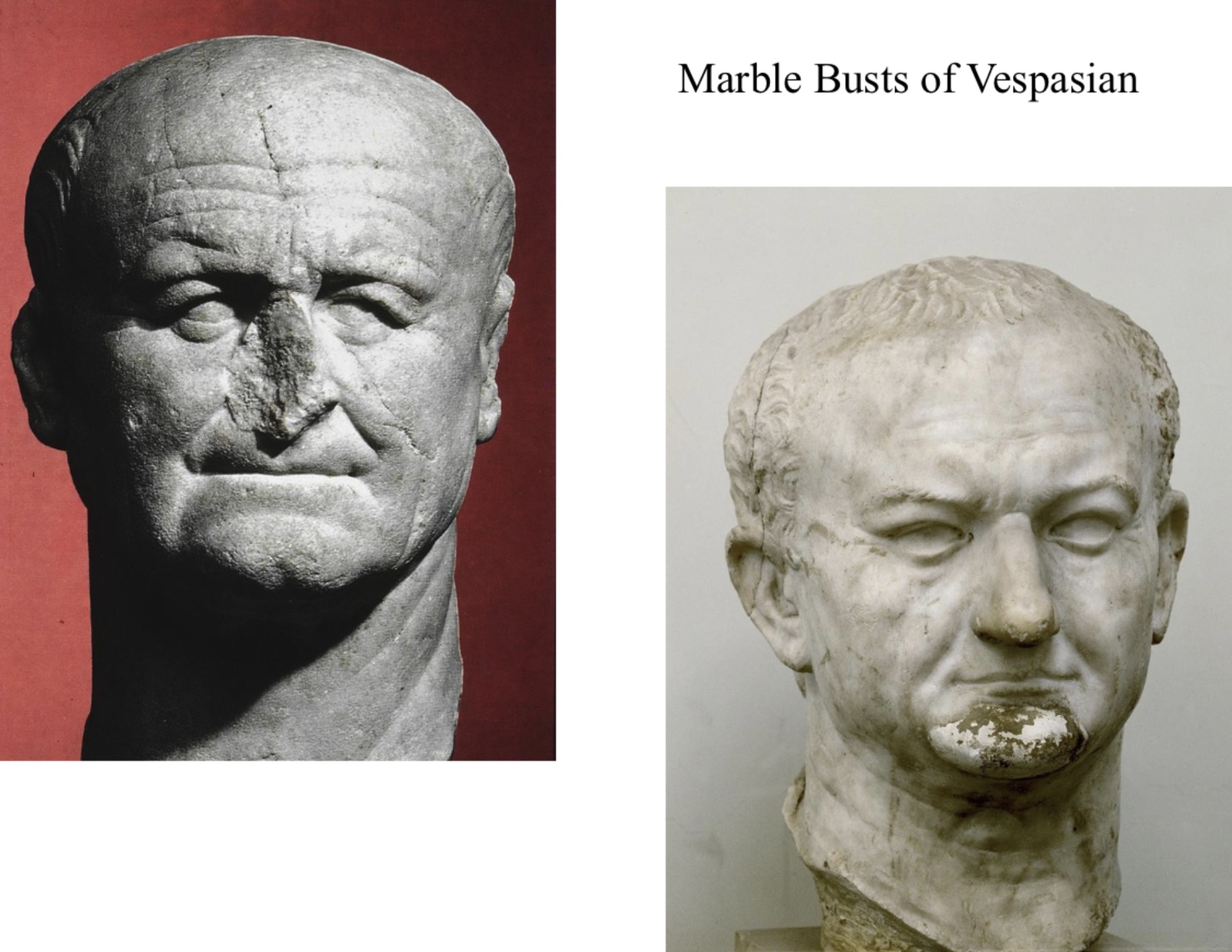
Busts of Vespasian
Sculptural portraits resembling the Roman Emperor Vespasian, created during his reign from 69 to 79 CE
characterized by realistic features and a depiction of his stern, aged expression.
These busts reflect the Roman ideal of verism, capturing the physical traits and personality of Vespasian, embracing authenticity over idealized beauty, and were used to promote his image as a relatable and trustworthy leader.
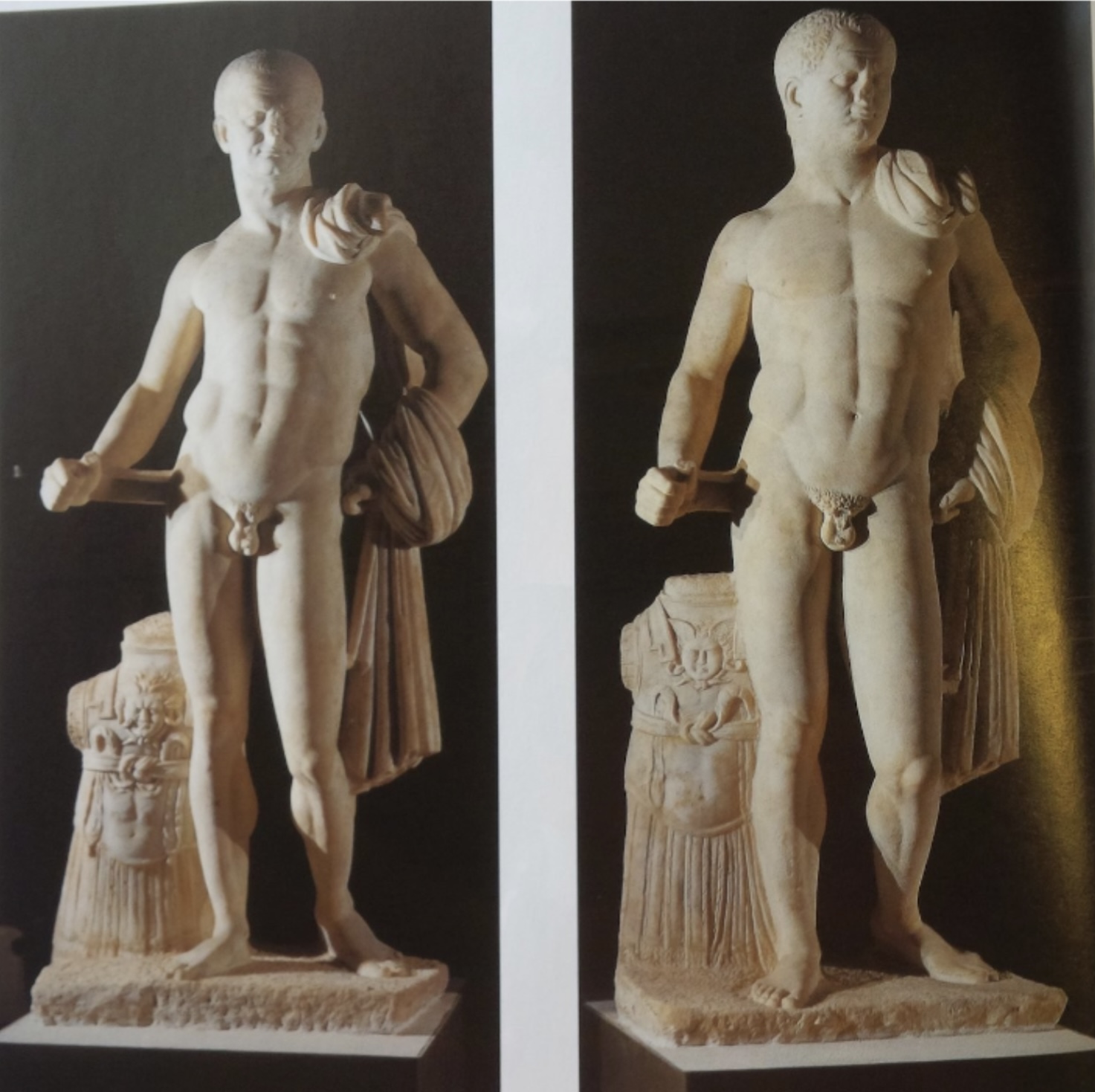
Statues of Vespasian and Titus
Profile head on frontal body
Contraposto
Bodies are idealized and doesn’t match up with Vespasians portrait busts
Sculptural representations of the Roman emperors Vespasian and Titus, showcasing a blend of idealized form and realism.
They exhibit characteristics of contraposto stance and the distinct portrait style, reflecting the transition from verism to a more classical representation of leadership.

Flavian amphitheater
A monumental structure in Rome, commonly known as the Colosseum, built during the Flavian dynasty.
it was used for gladiatorial contests and public spectacles, showcasing innovative engineering with its elliptical shape and tiered seating.
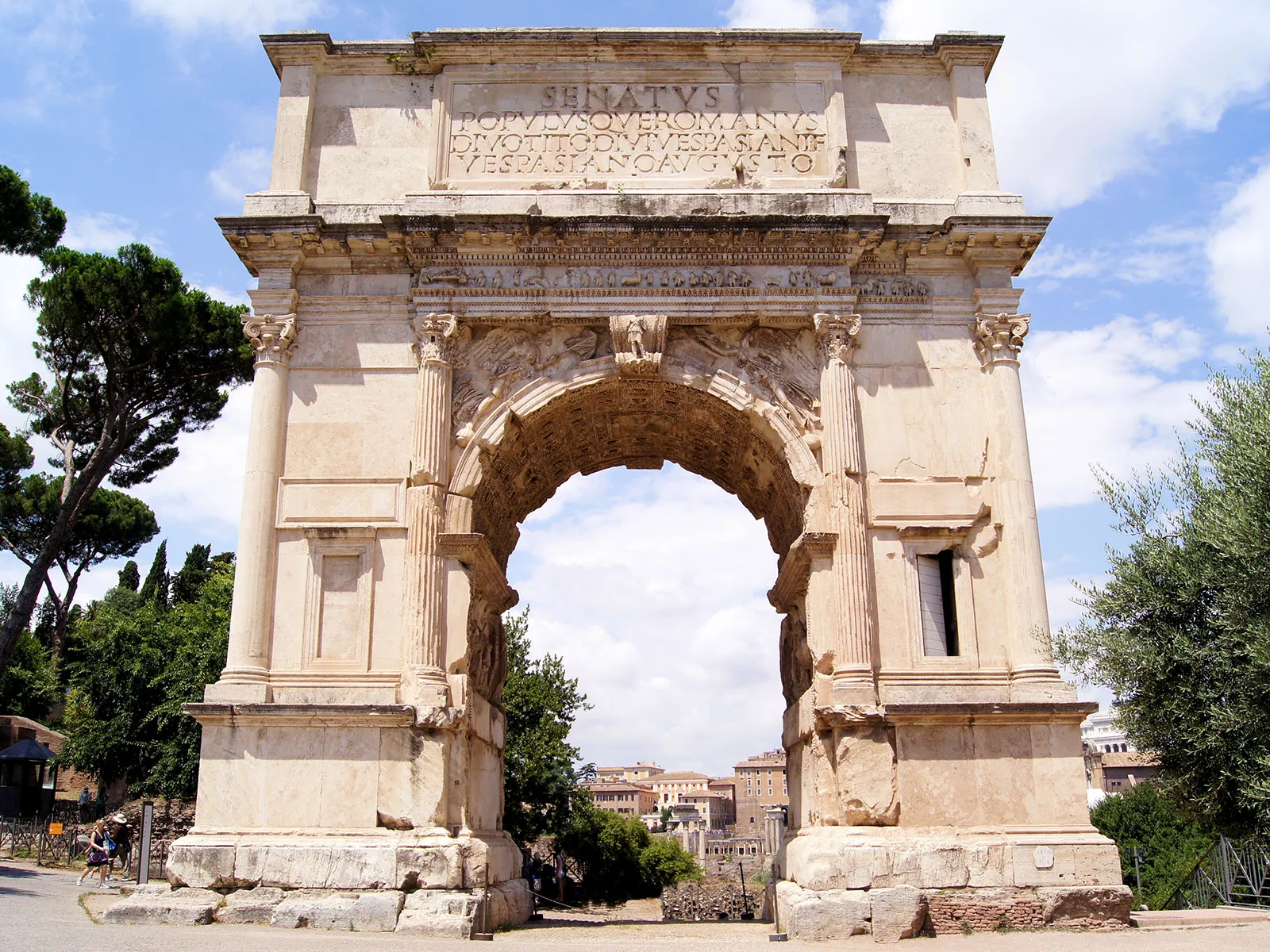
Arch of Titus
81 ce
50’ high, 40’ wide
Triumphal arch celebrating titus conquering judea
Not three arches like other triumphals
Large statue made of bronze wouldve been on top, thought to be a statue to titus driving a 4 horse chariot
Relief showing victory parade
Spandrals
Columns have ionic curls and corinthian foliage
On curved roof is a carving of titus riding an eagle
Another side of the arch shows a chariot scene
6’7
Shows titus and goddess victory in a 4 horse chariot surrounded by soldiers (left) and geniuses (right) of the roman people and of the senate
Genius - protective spirits
Another side shows a menorah scene
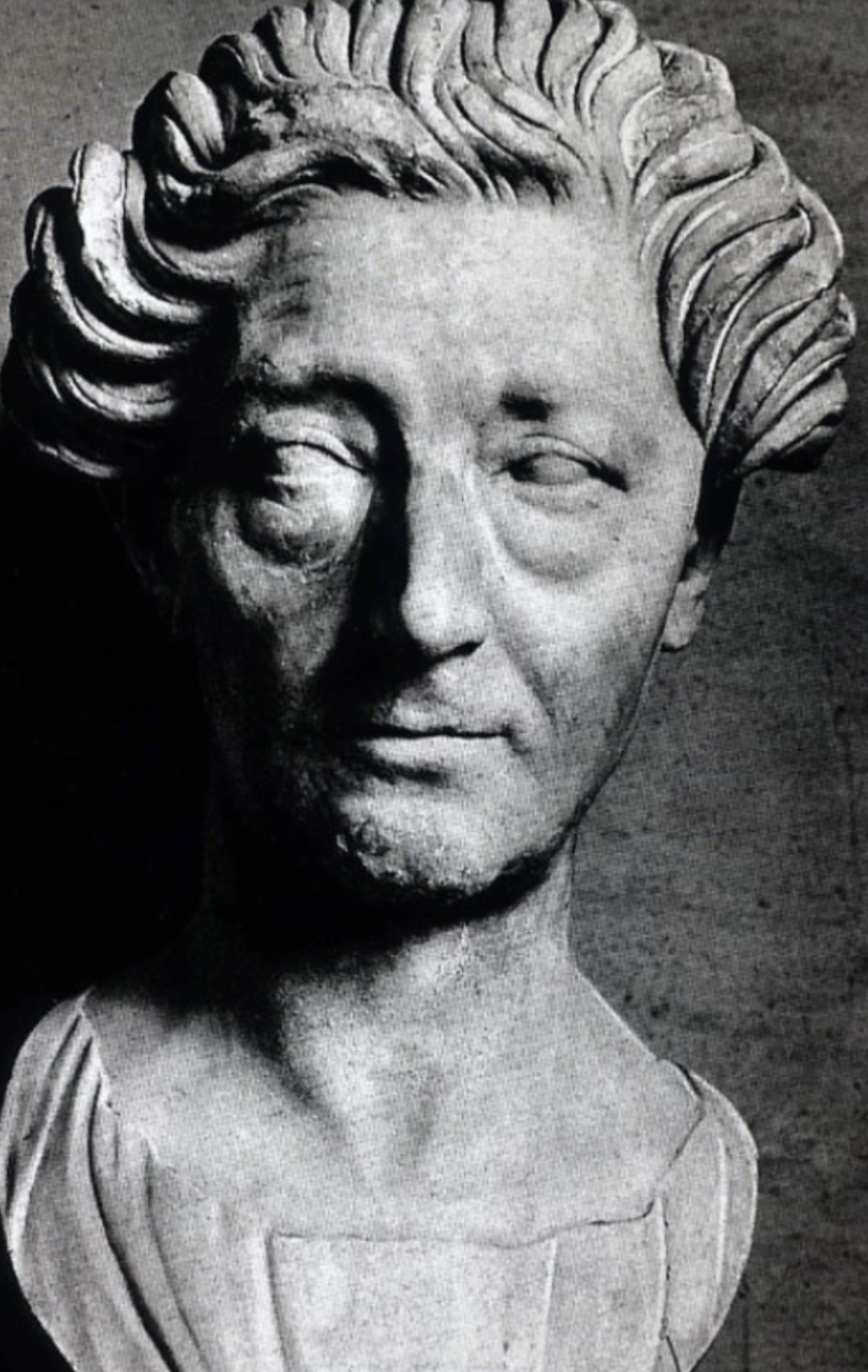
Old lady portrait bust
9.5”
Large, exaggerated eye bags
and a gaunt, melancholic expression, emphasizing the theme of verism in Roman portraiture. This bust showcases the harsh realities of aging and is a stark contrast to the idealized forms seen in other sculptures.
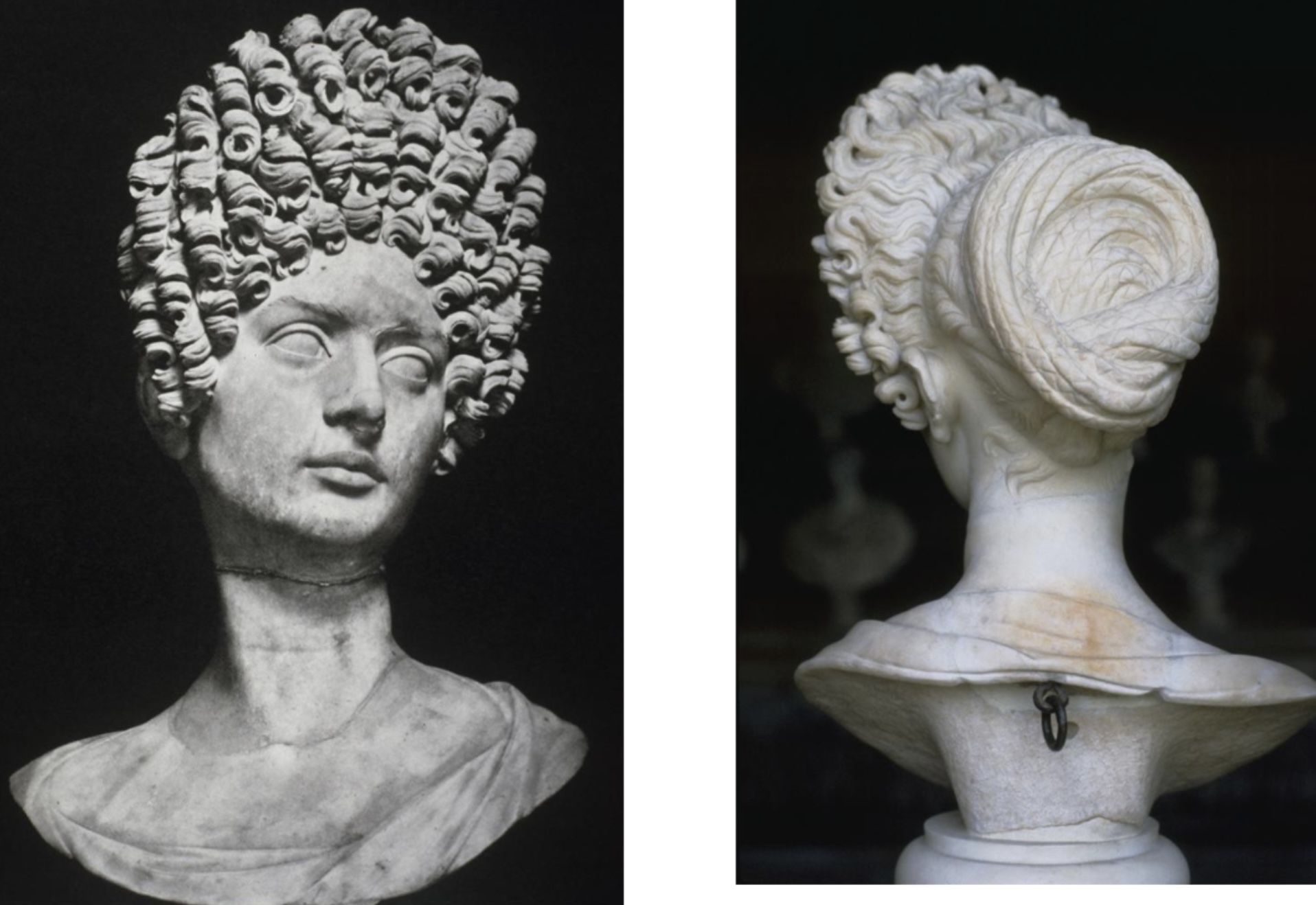
Lady with high curls
Smooth, young appearance in comparison to the older woman
Oversized eyes
Hairstyle has braided bun with a tall stack of curls in the front
A portrait that represents youth and vitality, characterized by smooth skin and a joyful expression, contrasting with the theme of verism.
The hairstyle includes a tall stack of curls and a braided bun, emphasizing elegance and beauty.

Roman woman as Venus
6.5’ tall
Contropossto
Commissioner depicted herself as venus
embodying beauty and ideal femininity, often used to convey divine qualities. The figure stands in a contrapposto pose, highlighting grace and elegance, which reinforces the connection to the goddess of love.
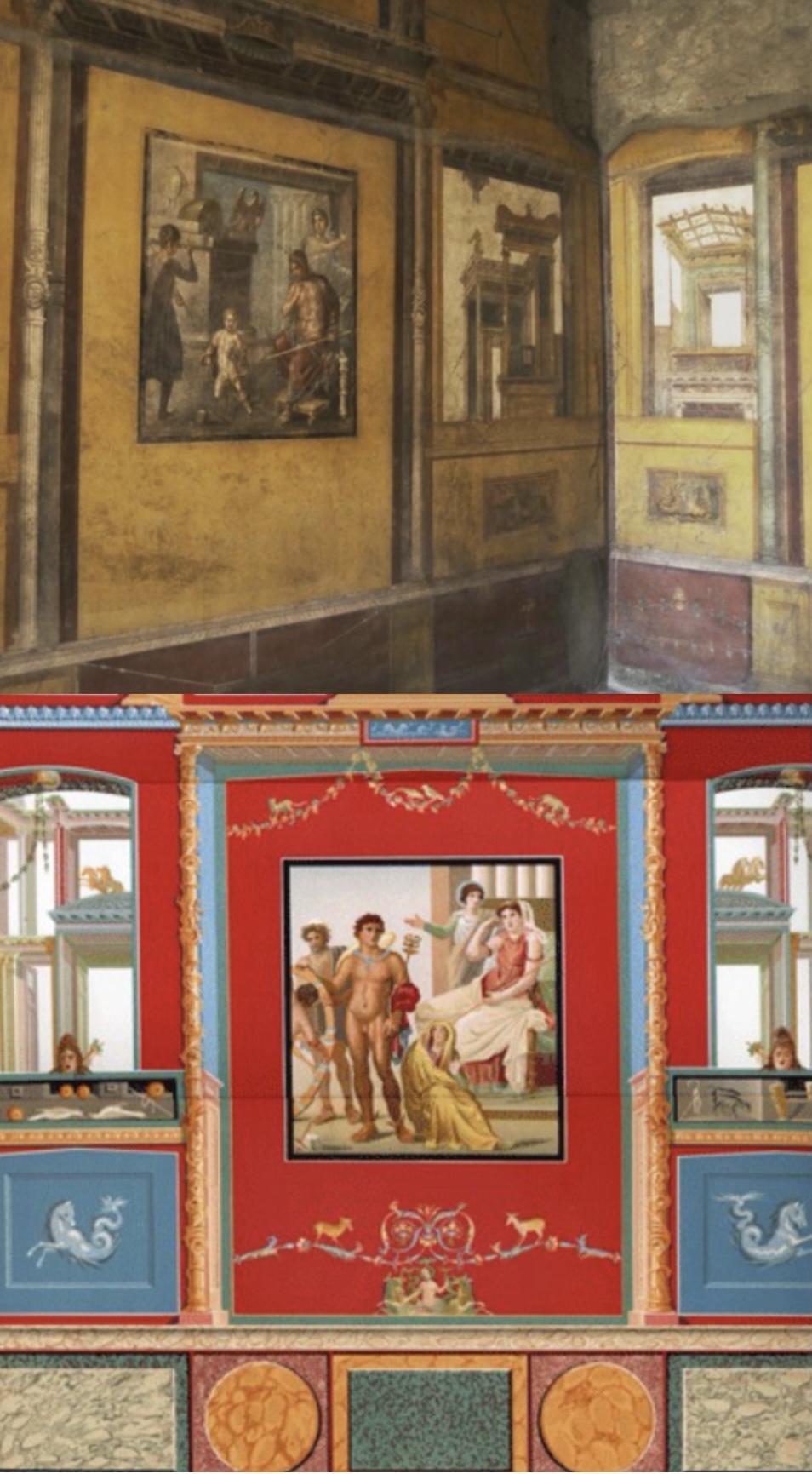
House of Vetti
Priapus
Shows priapus weighing his penis on a balance scale
He was considered a protective spirit in rome
Wall paintings - 4th style
Painted marble on the bottom
Thin columns
Pictures in painted frames
Windows into imaginary architecture
Mythological scenery
Infant hercules strangling a snake
Wall painting showing hercules strangling snakes that made their way into his crib as his parents watch
Atmospheric perspective in the background
Cupids as metalsmiths
More representative of 3rd style
Comedic depiction of cupids doing manufacturing jobs
The House of Vettii is famous for its elaborate frescoes that depict mythological themes and everyday life, showcasing the luxury and artistry of Roman villa design.
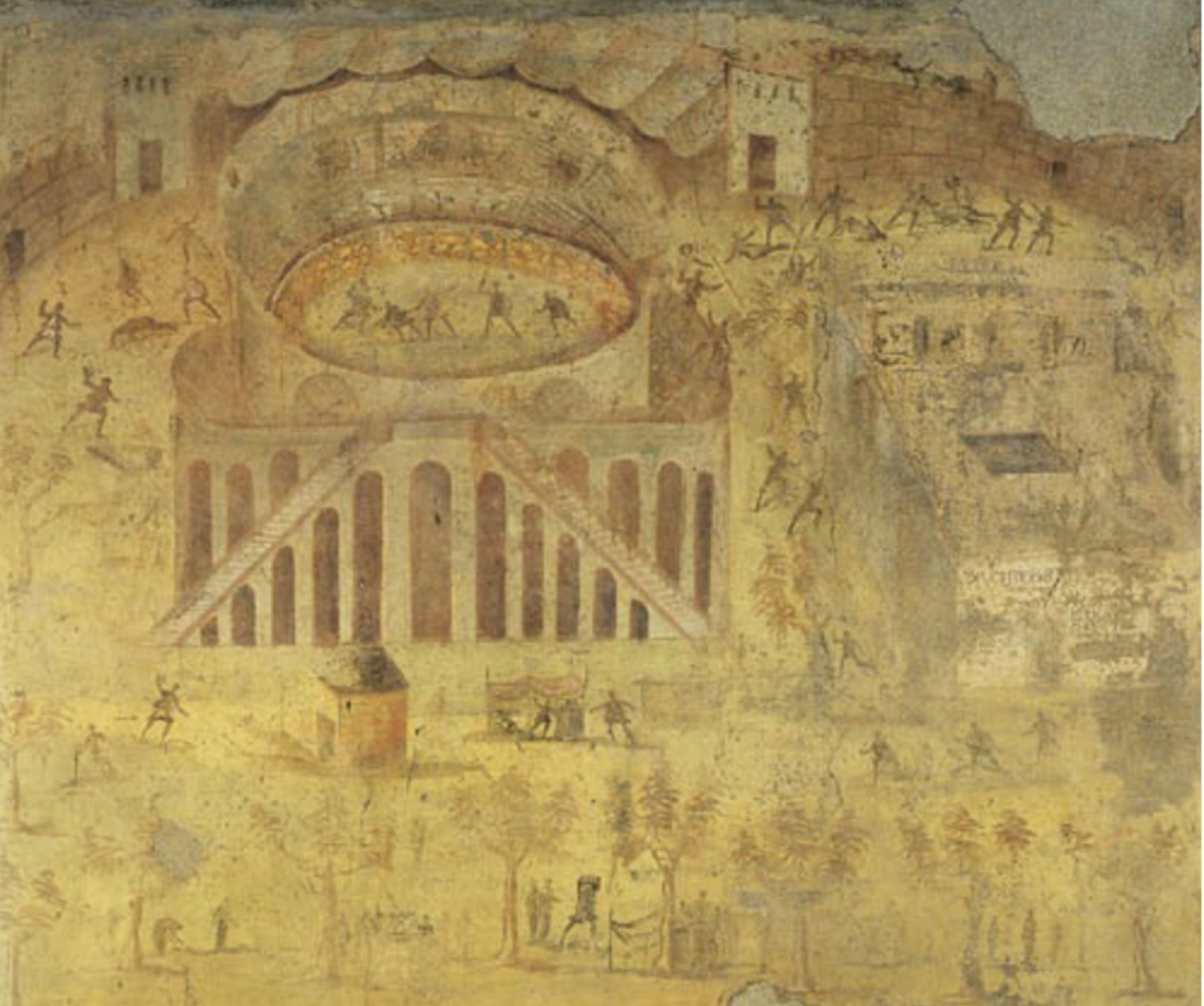
Riot in Pompeii Amphetheater
A violent confrontation that occurred in 59 AD during a gladiatorial games event, resulting in many casualties and leading to the Roman Senate banning games in Pompeii for ten years. This incident underscores the tensions between differing social classes in Roman society.
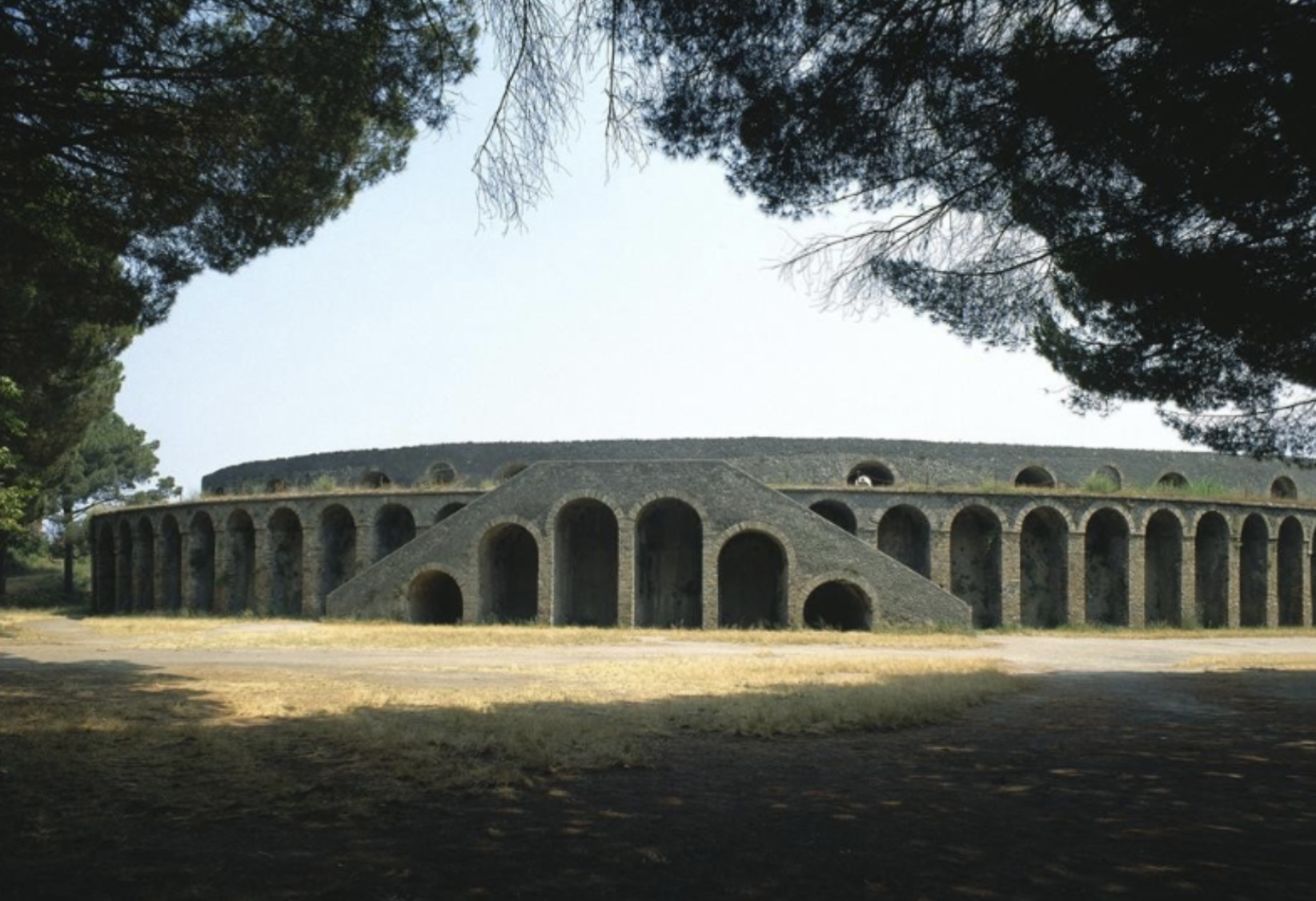
Pompeii Amphetheater
An ancient Roman amphitheater in Pompeii, known for hosting gladiatorial games and other public events, which illustrates the socio-political dynamics of the time.
Onyx cameo
a carved gemstone depicting intricate designs, often used in Roman jewelry.
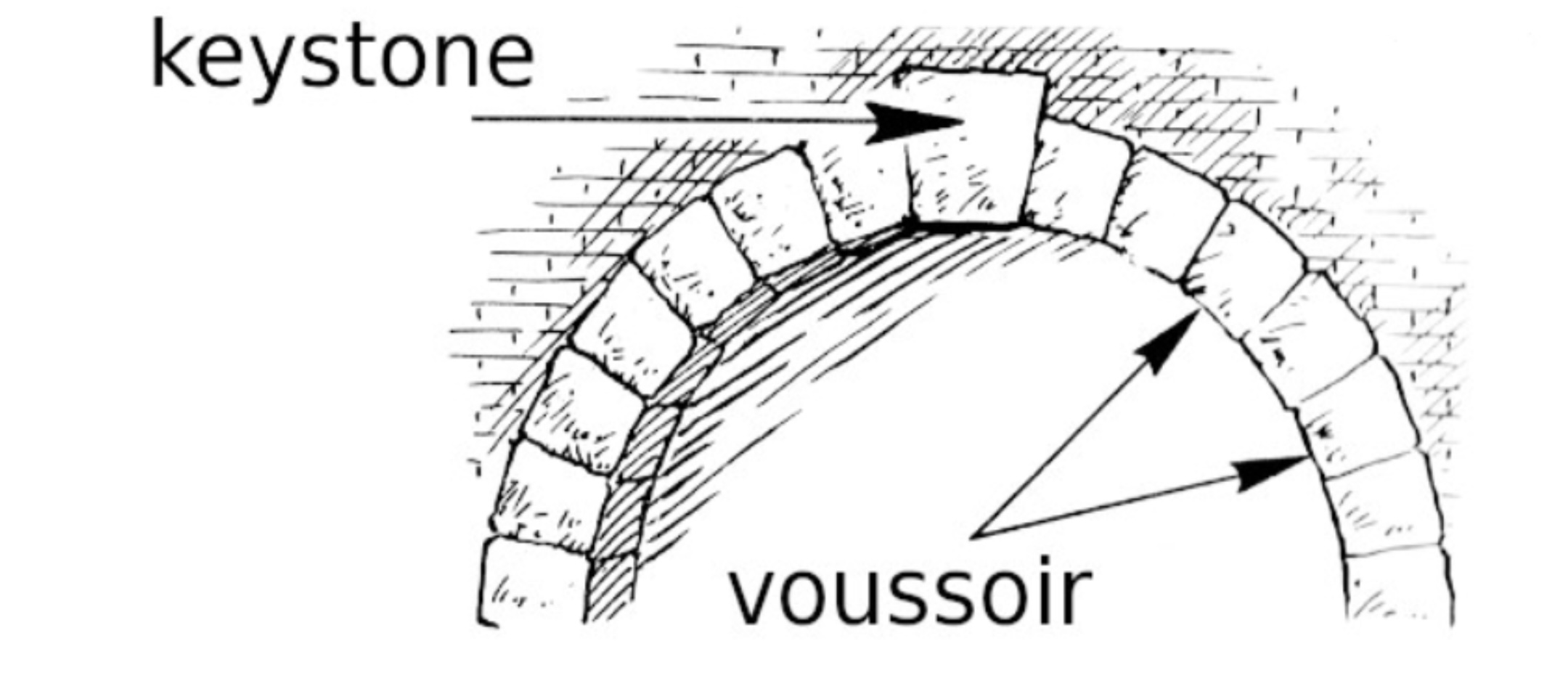
Voussoirs
wedge-shaped stones used in arch construction, crucial for supporting the structure.
Pilaster
a flattened column embedded in a wall, often used as a decorative element in architecture.
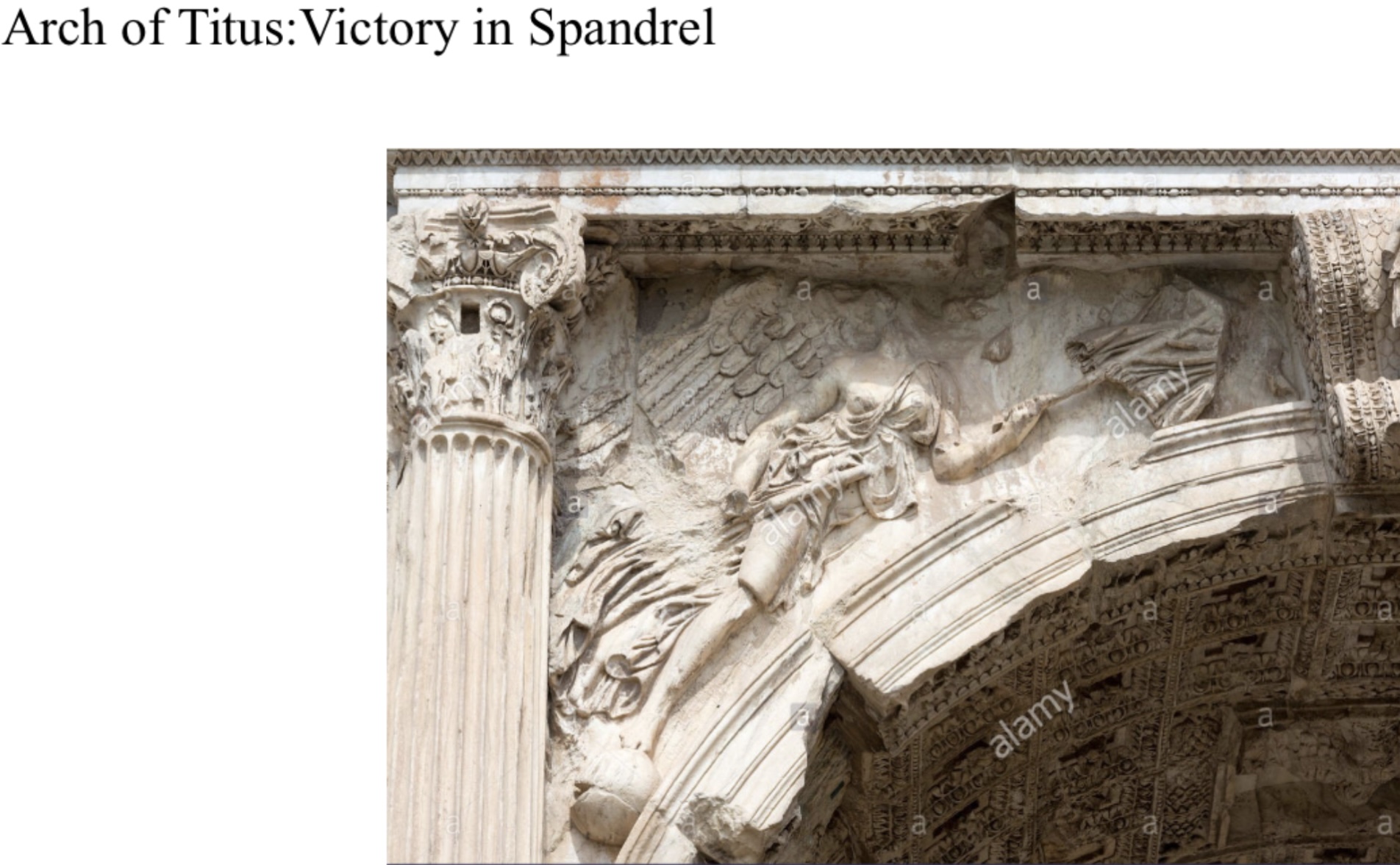
Spandrel
the triangular space between the outer curve of an arch and the square shape that surrounds it, often decorated in classical architecture.
Roman genius
a protective spirit of an individual's household or a place, embodying its character and essence.
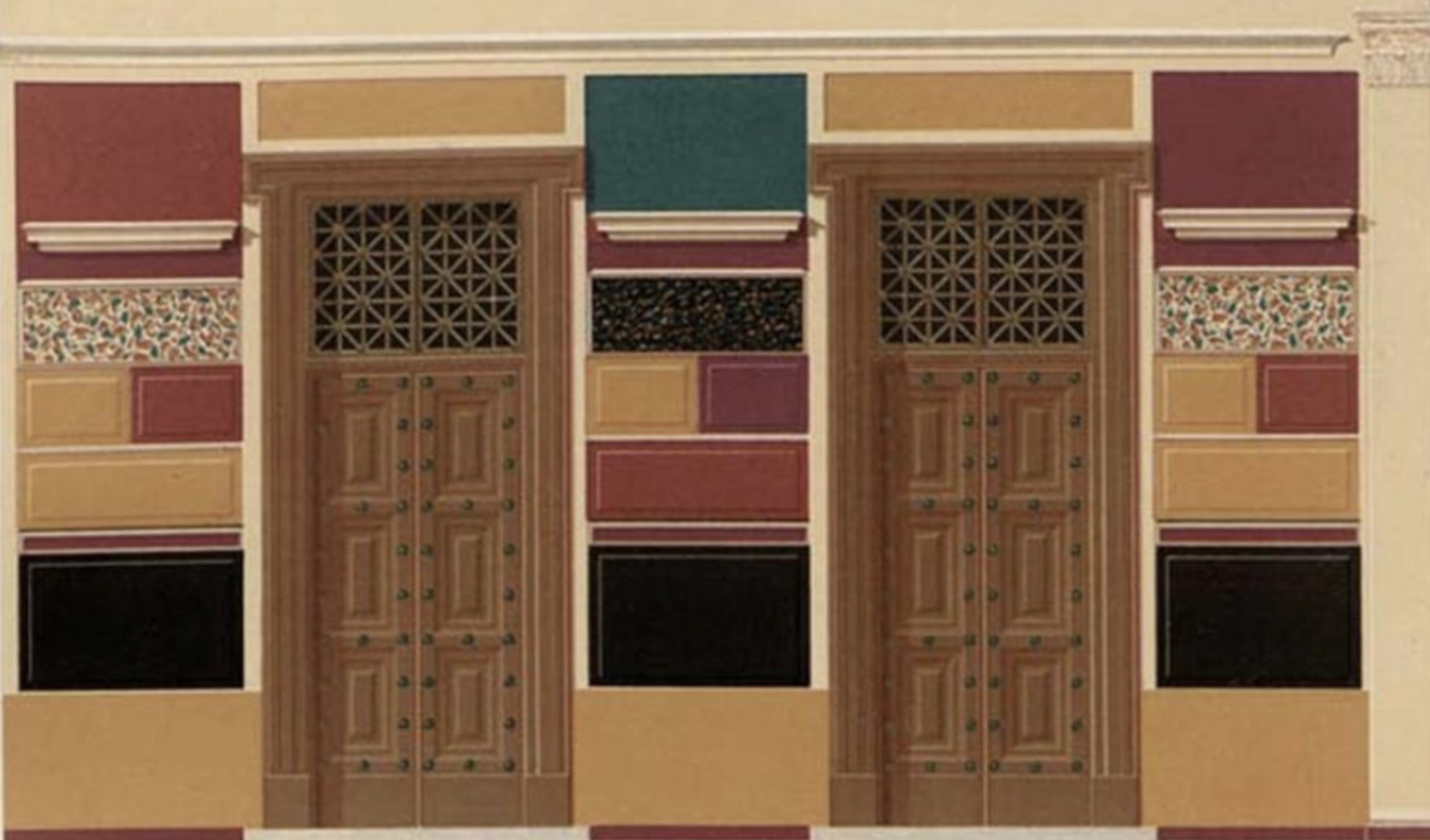
First style wall painting
A form of Roman wall painting characterized by the use of painted imitation marble panels, often employed to create the illusion of architectural spaces in domestic interiors.

Second style wall painting
A Roman wall painting style that aimed to create an illusion of three-dimensional space by using perspective and landscape elements, often depicting architectural features and scenic vistas.

Third style wall painting
A Roman wall painting style known for its monochromatic backgrounds and delicate, decorative motifs, often showcasing intricate details and mythological themes.
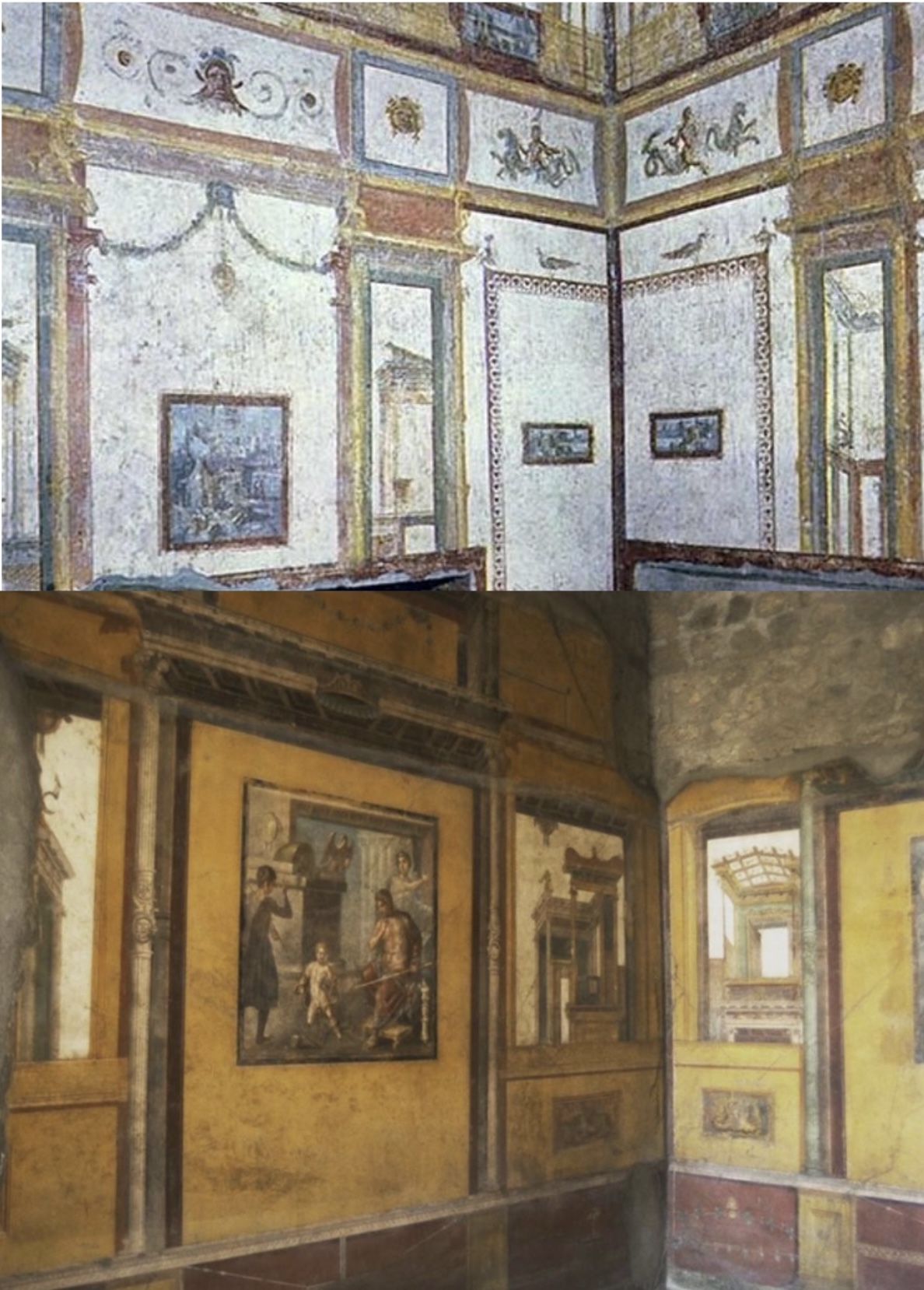
Fourth style wall painting
A Roman wall painting style that combines elements of the previous styles, characterized by complex and decorative compositions featuring a variety of motifs, often mixing architectural and mythological themes.

Mausoleum
A monumental tomb, often elaborately decorated, used primarily for the burial of significant figures in ancient Rome.
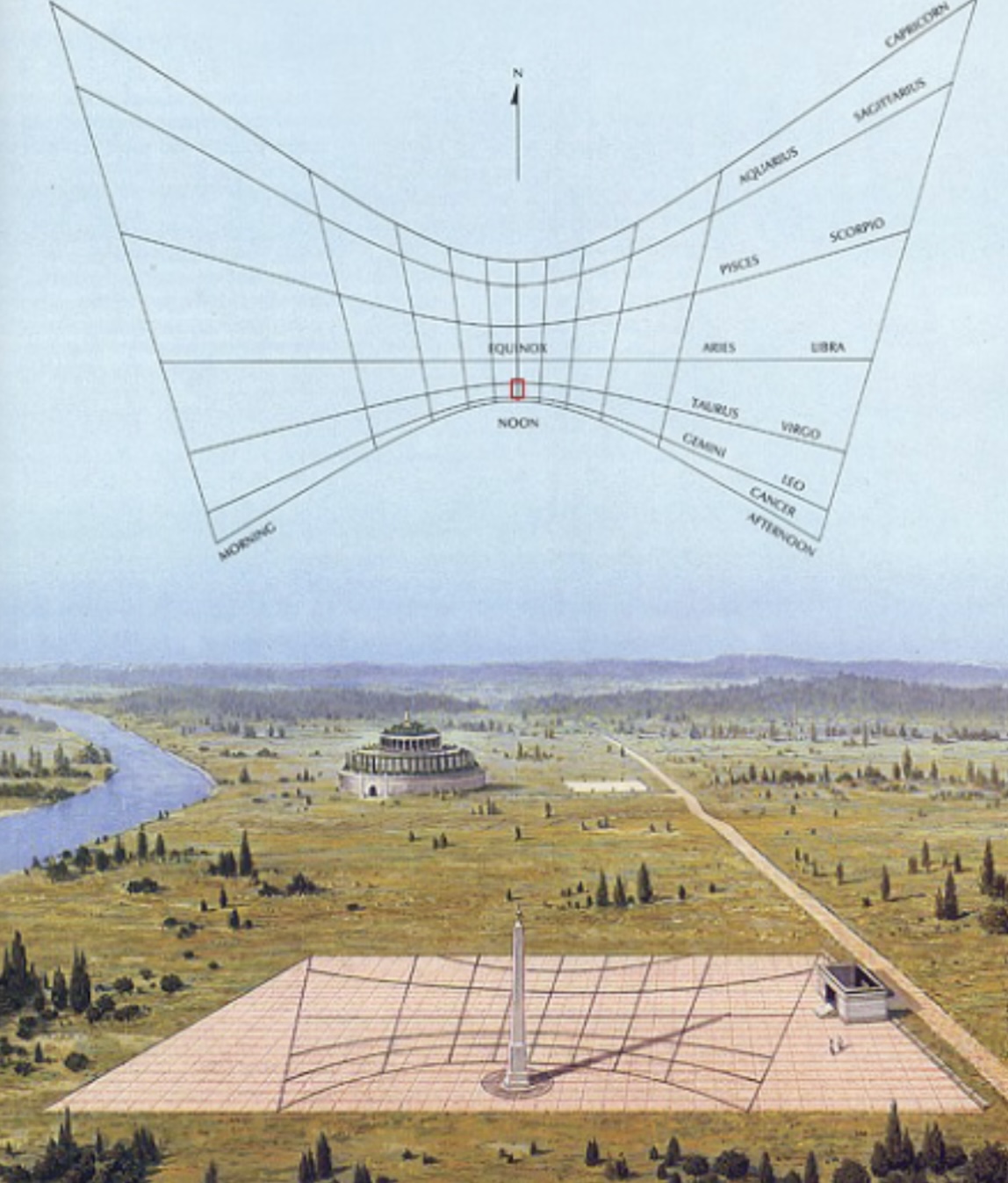
Horologium
A monumental sun dial built in ancient Rome, designed to indicate time using the position of the sun.

Corinthian columns
The most ornate of the three classical orders of ancient Greek architecture, characterized by a slender, fluted shaft and a decorative capital featuring acanthus leaves and scrolls.